Pumpkins in the Park is a harvest fair promoting environmental awareness and celebrating the fall season at Guadalupe River Park in San Jose, raising funds for its conservancy. It also features visits to the Cathedral Basilica of St. Joseph, a historic landmark with Greek cross ground plan, and the Rosicrucian Egyptian Museum, housing the largest collection of Egyptian artifacts on exhibit in western North America.
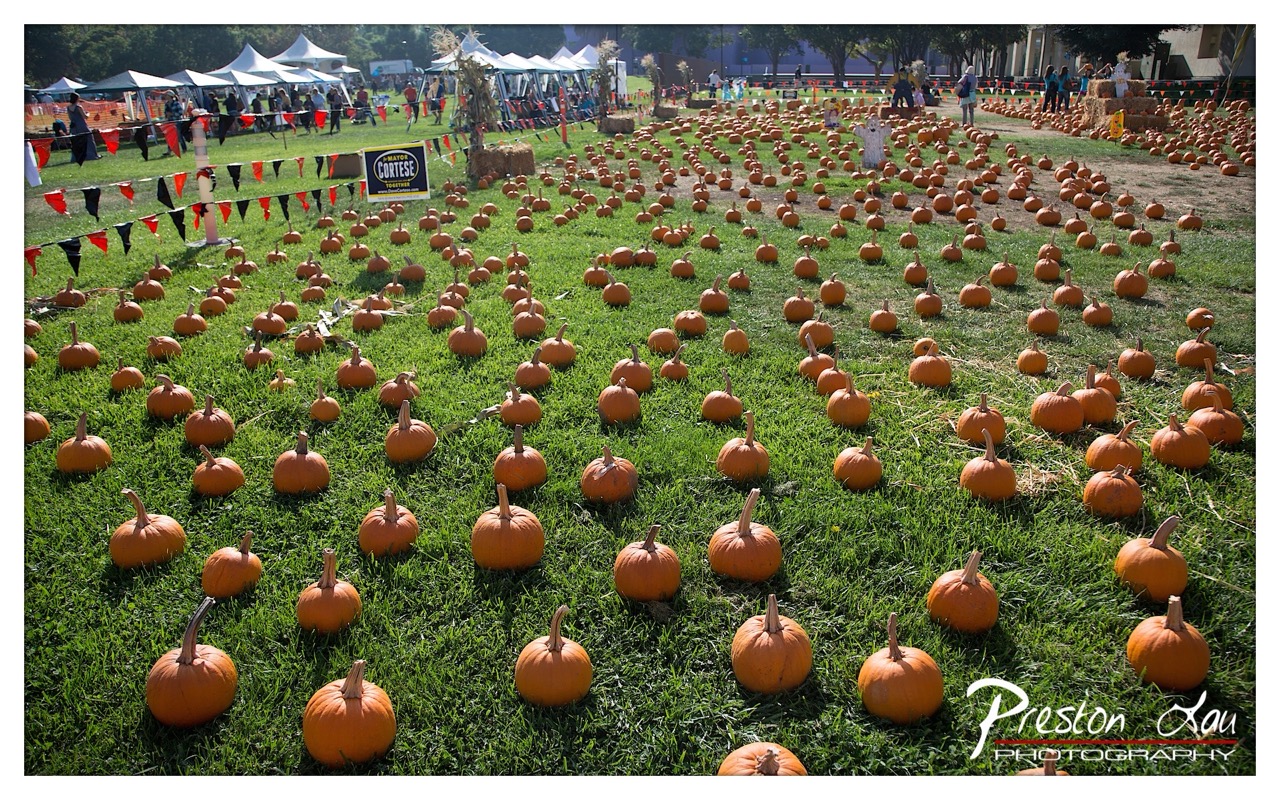

Autumn's Great Orange Invasion
Subject Rating: 9/10
Well, if you ever wondered what happens when a pumpkin patch decides to throw a party and invite *everyone*, this is it. The subject here is an overwhelming, glorious sea of orange orbs, neatly arranged (or maybe just aggressively sprawled) across a vibrant green lawn. It's an autumn festival of gourd proportions! What's happening is simply a massive display or sale of pumpkins, probably set up for some seasonal event. In the background, we see white tents, decorative flags in red and black, bales of hay, and scattered people browsing or managing the scene. The mood is undeniably festive and abundant, practically screaming "Pumpkin Spice Everything!" This photo captures the quintessential fall experience, minus the chilly air and sticky cider hands. It's a visual feast of seasonal cheer, proving that sometimes, more really is more, especially when it comes to potential jack-o'-lanterns or pie ingredients.
From a photography perspective, the composition effectively utilizes the sheer scale of the pumpkin field, drawing the eye from the foreground all the way back to the busy tents. The rows and individual pumpkins create a natural leading line, guiding the viewer's gaze through the scene. The lighting appears to be bright and sunny, which makes the orange pumpkins pop brilliantly against the green grass, though it might introduce some harsh shadows on closer inspection. The colors are rich and saturated, perfect for conveying that vibrant autumnal feel. The subject matter is straightforward but appealing – who doesn't love a massive pumpkin patch? The style is a straightforward wide-angle landscape, capturing the breadth of the scene. It's a classic depiction of a harvest-time event, perhaps slightly overwhelming in its abundance, but certainly effective at conveying the scale and festive nature of the scene. And, of course, the photographer's watermark is subtly (or maybe not so subtly) present, claiming ownership of this gourd gallery.
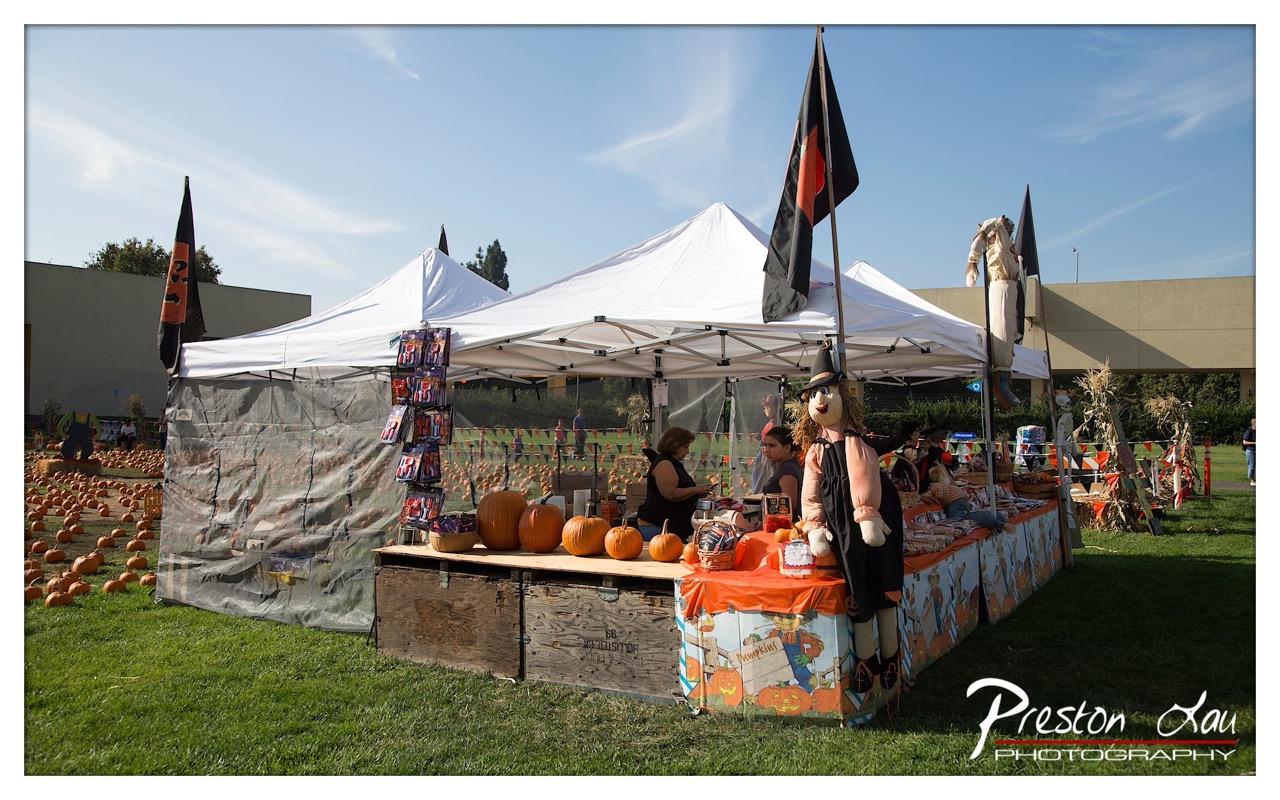

Autumnal Harvest & Spooky Sales
Rating: 8/10 (for capturing the spirit of the season)
Welcome to what appears to be peak October, captured perfectly under a bright blue sky. The scene unfolds around a pair of large white tents, serving as the command center for a Halloween operation selling all things spooky and squash-related. Piles of pumpkins, ranging from dinner-plate size to slightly-larger-than-your-head, line the front display, enticing potential buyers. Perched strategically is a large scarecrow in overalls and a witch hat, standing guard over the merchandise, looking only mildly less unnerving than some real-life shoppers on Black Friday. Inside the tent, amidst hanging bags of what look like costumes or accessories, vendors are busy, presumably discussing the optimal strategy for pumpkin placement or scarecrow posture. The overall mood is undeniably festive and buzzing with autumnal energy, set against a backdrop of green grass, distant buildings, and a seemingly endless field of orange orbs in the background left.
From a photographic standpoint, the image captures the scene's vibrancy well, thanks largely to the clear, sunny day which makes the colors pop, especially the rich oranges against the green grass and the blue sky. However, the harsh direct sunlight results in some strong shadows, particularly under the tent and on the right side of objects, which is always a tricky beast to wrangle. Compositionally, the tents dominate the frame, slightly off-center, leading the eye towards the heart of the activity. The foreground scarecrow acts as a fun visual anchor, adding a touch of whimsical creepiness. The inclusion of the pumpkin patch in the background provides context and reinforces the harvest theme. While the lighting could be softer for more flattering details under the tent, it effectively conveys the bright, lively atmosphere of an outdoor seasonal market. The watermark subtly reminds us this is someone's professional take on a very gourd-geous day.
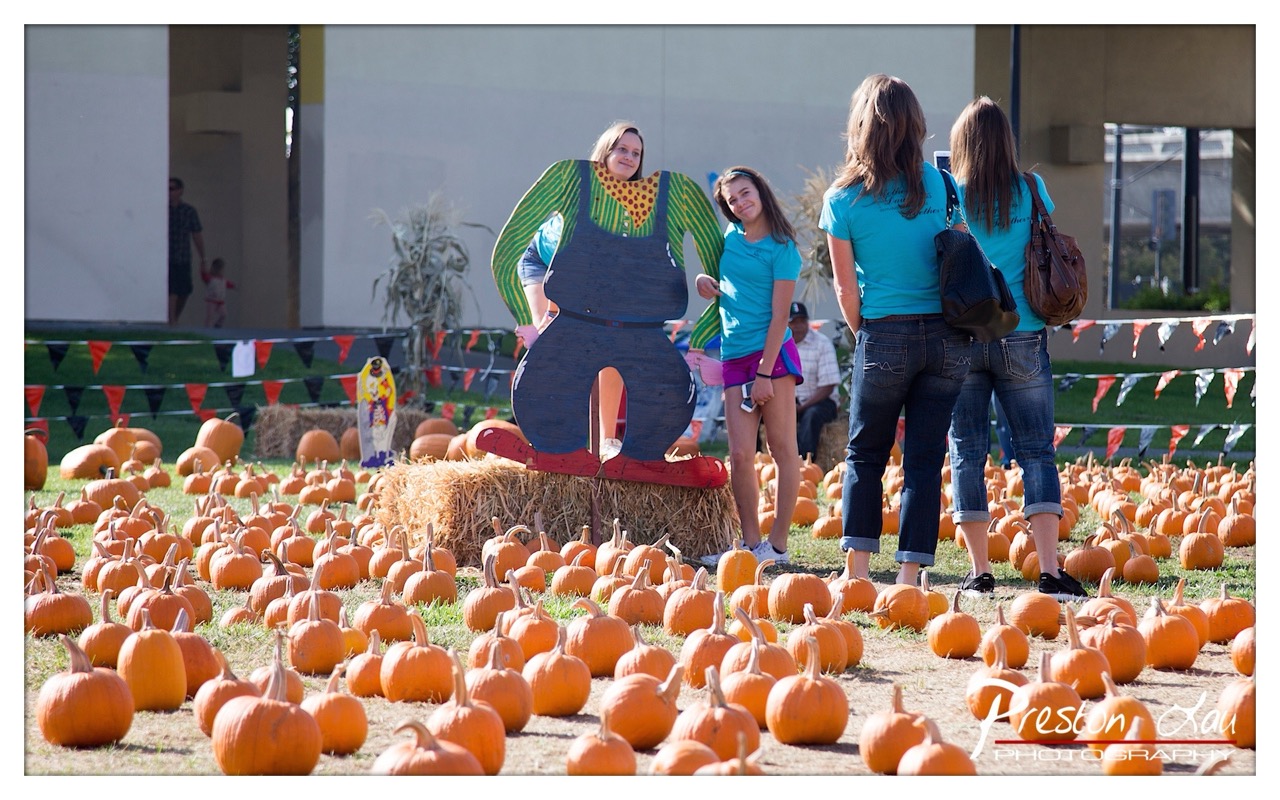

Pumpkin Patch Hijinks
Subject Rating: 7/10
Welcome to peak autumnal aesthetic, where pumpkins are abundant and oversized cutout figures apparently roam free! This scene captures the classic vibe of a pumpkin patch, overflowing with countless orange gourds scattered across a grassy field. The mood is clearly festive and fun, centering around three women and a giant, grinning, overall-clad cutout character standing proudly on a hay bale. It looks like a perfect spot for capturing those essential fall memories, even if one of the main 'subjects' is made of plywood and likely the cause of several nightmares after dark.
From a photographic standpoint, the composition is a layered delight (or challenge, depending on how you look at it!), with a dense foreground of pumpkins leading the eye up to the human and cardboard subjects in the mid-ground. The background is a bit plain with the large building, but the festive flags and distant corn stalks add a touch of seasonal flair. The bright natural lighting is doing its job, though it might be a tad harsh, causing some deep shadows – perfect for emphasizing those pumpkin textures, less so for flawless portraits, perhaps. The color palette is wonderfully warm and autumnal, dominated by the vibrant oranges against the greens and blues of the clothing. It's a candid snapshot capturing a lively moment at this harvest hotspot, complete with a signature addition that begs the question: who *doesn't* want a photo with a giant, slightly creepy, flat farmer?
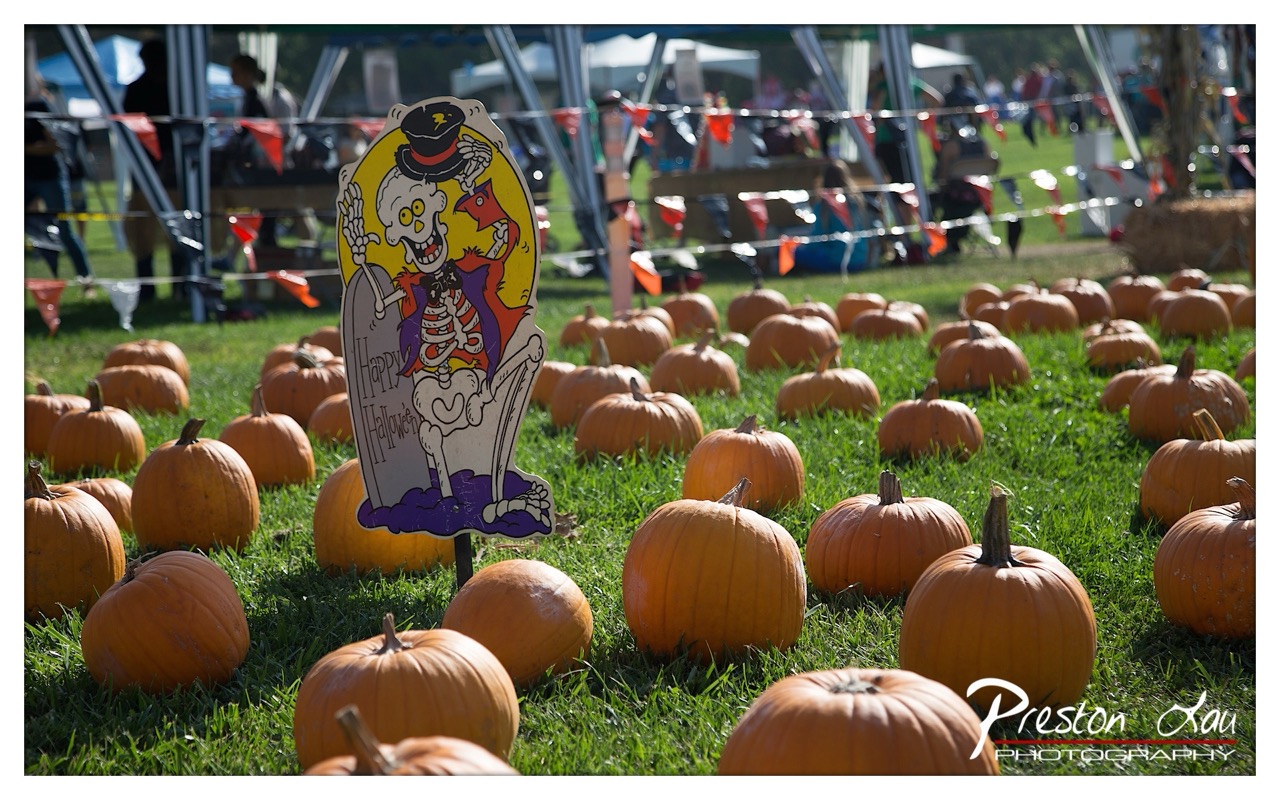

Pumpkin Patch Party Crasher
Rating: 8/10 (Subject)
Well, look what we have here – a veritable sea of potential jack-o'-lanterns, guarded by what appears to be a rather enthusiastic skeletal gentleman in a top hat and cape. He seems awfully excited to wish everyone a "Happy Halloween" from his conveniently located tombstone sign. The scene is classic autumnal festivity, brimming with ripe, orange pumpkins scattered across a lush green lawn. It captures the spirit of a pumpkin patch or a fall festival setup perfectly, evoking a sense of family fun, crisp air, and the looming excitement of spooky season. Beyond the pumpkins and the dapper skeleton greeter, you can spot a stray hay bale, adding another layer to the rustic, harvest-time vibe. It's a visual invitation to pick your perfect gourd and maybe get a little spooked by a cardboard cutout.
From a photography standpoint, the composition is dominated by the foreground pumpkins leading back towards the slightly off-center Halloween sign, which acts as a clear visual anchor. The photographer has opted for a relatively shallow depth of field, blurring the background into a pleasant bokeh that separates the vibrant orange subjects from the busy scene behind them. The lighting appears to be bright daylight, which beautifully illuminates the pumpkins' textures but might be a tad strong, creating some punchy highlights and shadows. The color palette is dominated by warm oranges and greens, quintessential fall tones, accented by the sign's more vibrant, slightly cheesy purple and yellow. The background, while blurred, clearly indicates a lively event with tents, banners, and blurry figures, providing context without being distracting. Overall, it's a well-executed shot for the subject matter, capturing the festive mood effectively, though maybe the skeleton sign could have struck a slightly more menacing (or perhaps just less *happy*) pose. Points deducted for the skeleton clearly outshining some of the pumpkins in terms of personality.
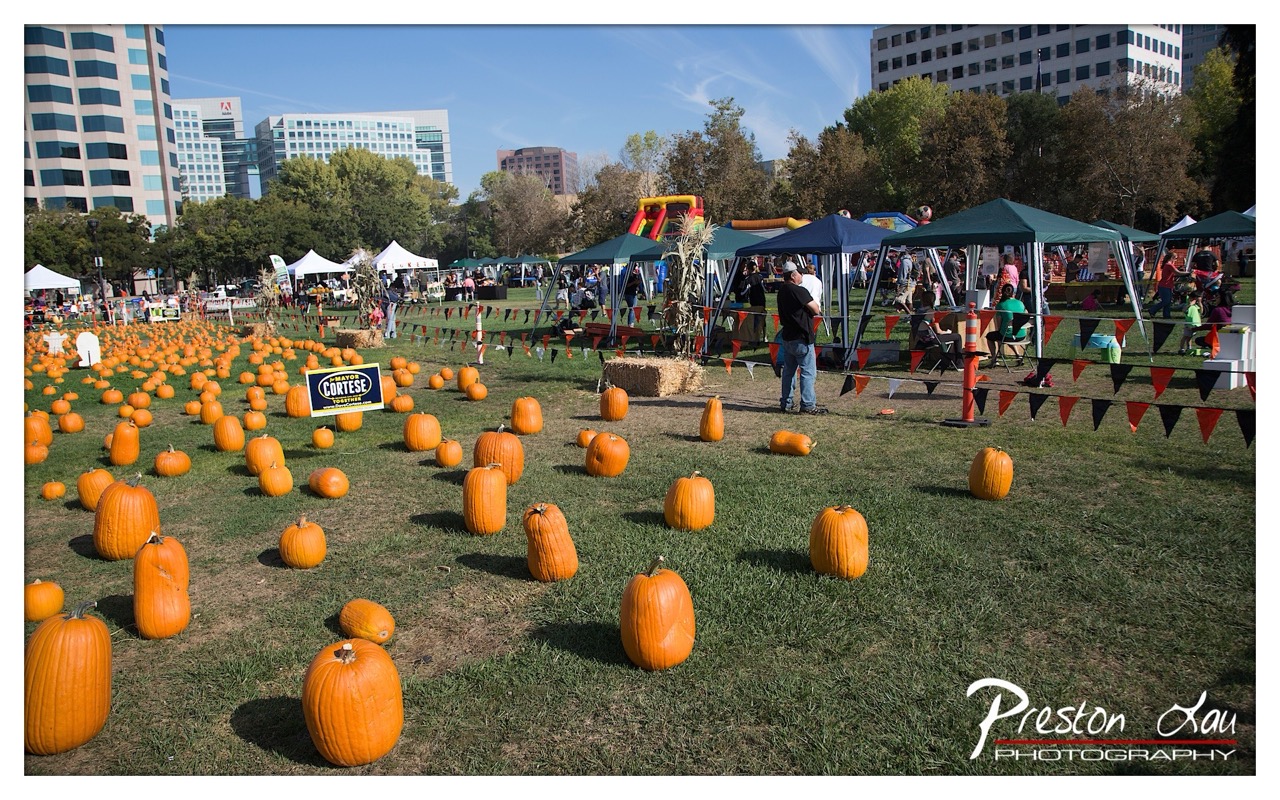

Pumpkin Patch Pandemonium
Subject Rating: 6/10
Welcome to Peak Autumn, where the lawn is literally paved with orange spheres! This shot captures a bustling pumpkin patch scene, likely a weekend festival given the crowds and myriad tents. In the foreground, a veritable army of pumpkins occupies the frame, ranging from proud, plump specimens ready for carving to smaller contenders just chilling in the grass. People are milling about under various pop-up tents in the mid-ground, engaging in what one presumes are important pumpkin-related transactions or enjoying event activities, including what appears to be a bouncy castle lurking further back. The mood is undeniably sunny and festive, embodying the spirit of a classic fall community gathering under a clear blue sky.
From a photographic standpoint, the composition is a bit of a visual scatter plot – lots of pumpkins, people, and tents vying for attention. While the sheer volume of pumpkins in the foreground gives a sense of the scale, they feel somewhat randomly placed, like they just landed there after a particularly enthusiastic giant flung them. The mid-day sun is bright and paints everything in vibrant, albeit slightly harsh, light, casting distinct shadows but flattening the textures on those glorious gourds. The backdrop features some modern high-rise buildings, adding an unexpected urban element to the otherwise pastoral-adjacent scene, and the triangular bunting provides a touch of graphic interest, leading the eye vaguely towards the activity zone. Overall, it's a competent record of the event, perhaps more documentary than artistically composed, perfectly capturing the joyous chaos of a standard-issue pumpkin patch. And yes, the photographer's watermark is strategically placed, a final flourish on this orange-drenched spectacle.
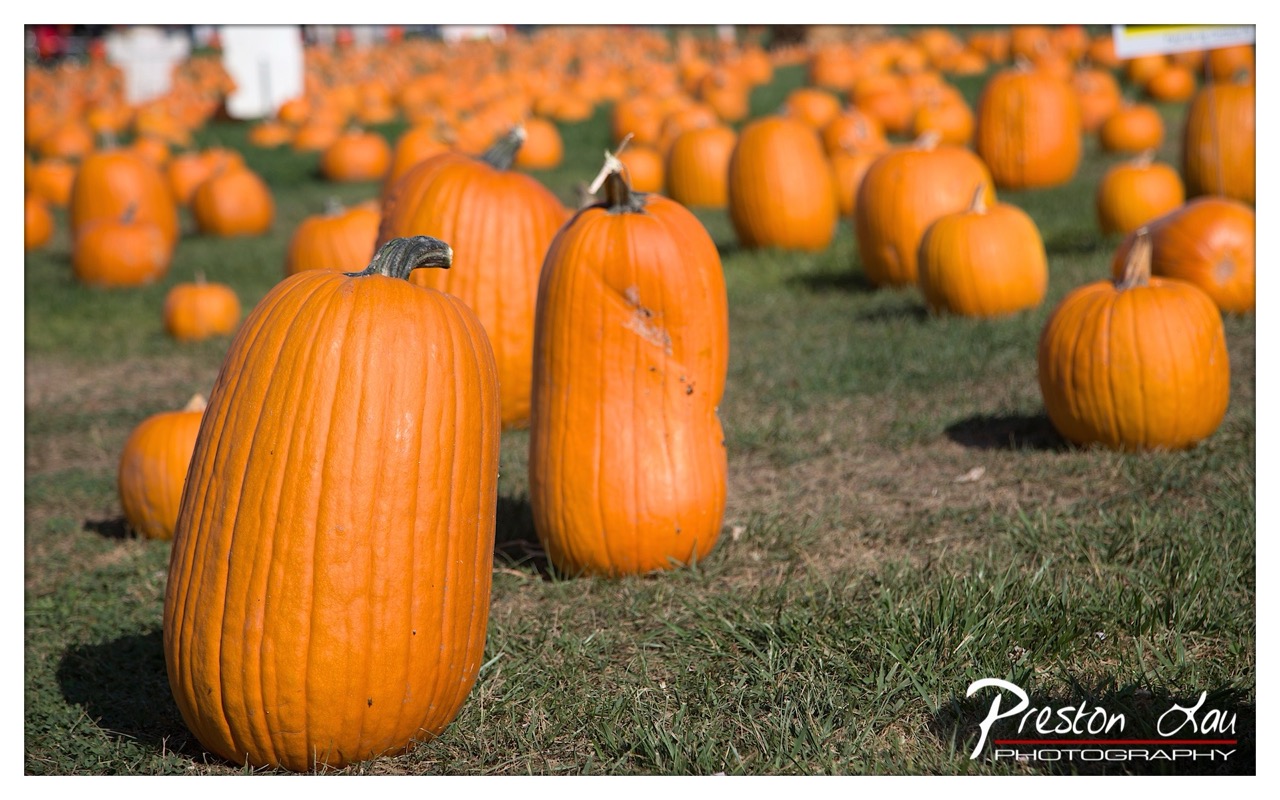

Title: The Great Pumpkin Patchening
Rating: 8/10
Behold, the glorious pumpkin patch! This image delivers a stunning, almost overwhelming, display of orange spheres scattered across a field, rating the overall scene an solid 8/10 for its sheer abundance and festive appeal. What's happening here is a veritable pumpkin explosion, a riot of autumnal harvest that stretches into the distance, making you wonder if there's a single patch of ground left uncovered. The mood is pure harvest season optimism, a feeling of bountiful yield that's only slightly tempered by the daunting task of actually *picking* one from this overwhelming crowd.
Photographically speaking, the composition places several pumpkins prominently in the foreground, acting as leading elements to guide the eye into the vast, blurry background sea of their brethren. That tall, ribbed pumpkin on the left is a great anchor, although the slight crop on the right edge of the central pumpkin feels a *tiny* bit tight. The lighting is bright and sunny, creating lovely vibrant orange hues that contrast beautifully with the green and brown grass, while also producing defined shadows that add texture. The depth of field is shallow enough to isolate the foreground subjects but still allows the background pumpkins to be recognizable, effectively conveying the scale of the operation. You can spot some distant white structures, perhaps tents or buildings, hinting at the commercial aspect of this autumnal spectacle. It's a straightforward, effective shot capturing the essence of a large pumpkin patch, complete with the photographer's watermark tucked neatly in the corner – a good place to sign off on this sea of squash.
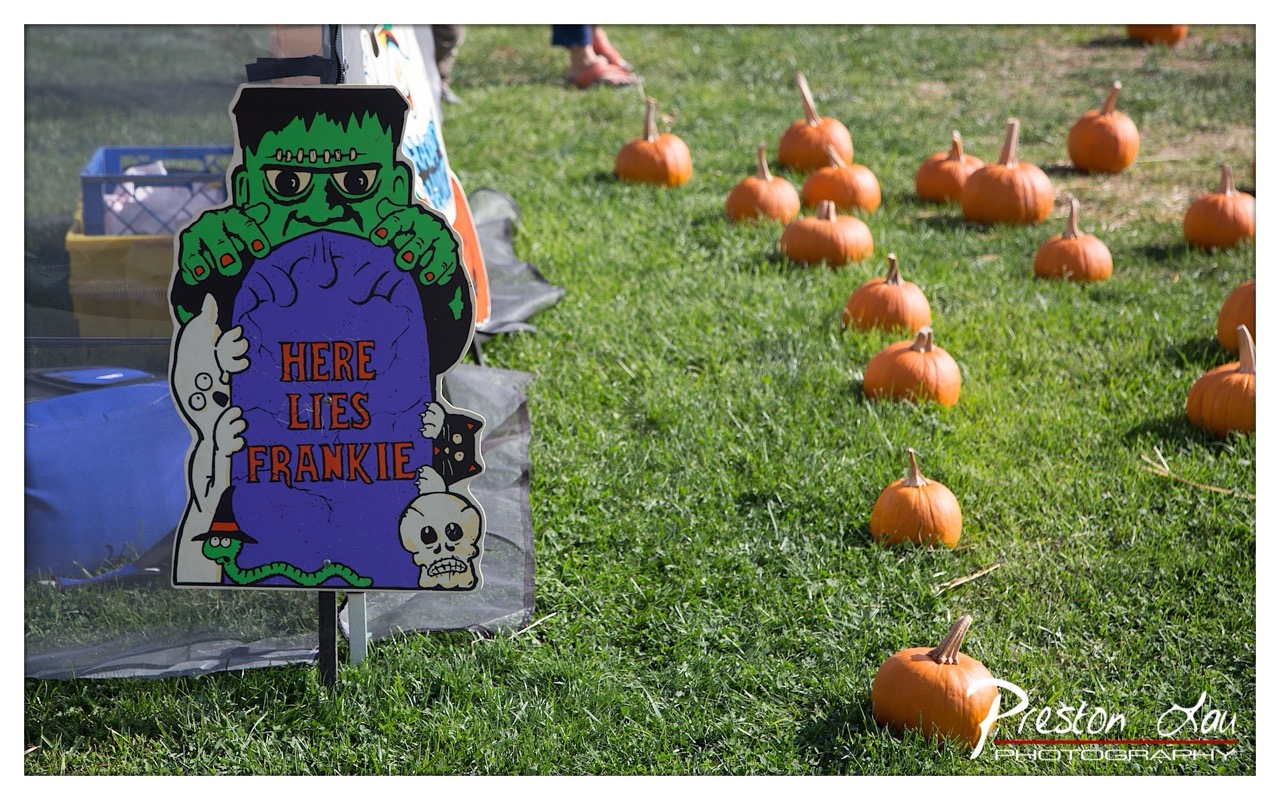

Halloween Hauntings & Harvests
Rating: 7/10
This delightful autumn scene captures the spooky spirit of the season with a fun, quirky foreground element. Dominating the left side is a cutout sign featuring a classic green Frankenstein's monster clutching a tombstone that reads "HERE LIES FRANKIE," surrounded by mischievous cartoon Halloween creatures like a wide-eyed ghost, a black cat with spooky eyes, a slithering snake wearing a witch's hat, and a grinning skull. It looks like a decoration or game marker for a pumpkin patch or fall festival. Scattered across the bright green grass are numerous small, vibrant orange pumpkins, some appearing closer and larger, others fading into the background. The overall mood is lighthearted, festive, and perfect for a crisp fall day outing.
From a photographic perspective, the shallow depth of field effectively isolates the foreground sign and the closest pumpkins, creating a nice separation from the busy background. The composition places the main subject (the sign) slightly off-center, giving visual weight to the left while the line of pumpkins leads the eye diagonally into the frame, adding depth. The lighting appears to be natural sunlight, casting subtle shadows but overall providing good, even illumination that brings out the rich greens of the grass and the warm oranges and purples of the decorations. Perhaps a polarizing filter could have deepened the green of the grass even further, but the current colors are certainly seasonal and appealing. The background, though blurred, hints at the activity beyond with glimpses of people's legs, a tent structure, and crates, suggesting a bustling event without being distracting.
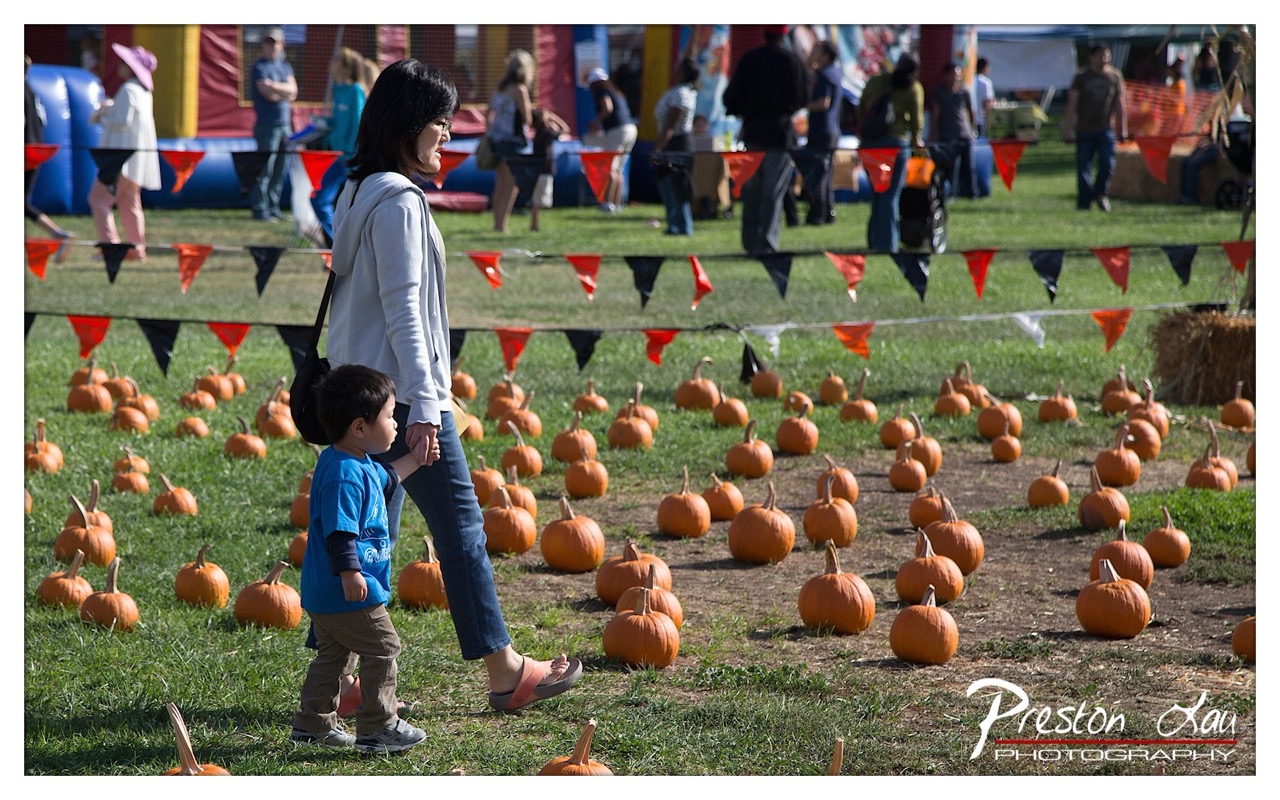

Autumn Stroll in the Pumpkin Patch
Subject Rating: 8/10
This charming candid shot captures a classic fall scene: a mother and child navigating a field of pumpkins. The subjects, a woman and her young son, are beautifully framed as they walk hand-in-hand, their connection forming the emotional core of the image. They are placed slightly off-center, drawing the viewer's eye along their path through the scattered orange gourds. The boy's blue shirt and the mother's grey hoodie provide subtle points of color contrast against the predominantly warm autumnal palette of orange pumpkins and green/brown grass. The mood is warm, familial, and captures the simple joy of an outing during the fall season.
From a technical standpoint, the photograph successfully uses a shallow depth of field to separate the main subjects from the busy background. While the background shows a typical festival scene with flags, people, and even a glimpse of an inflatable structure, the soft blur ensures that the focus remains squarely on the mother and child and the foreground pumpkins. The natural lighting is gentle, casting soft shadows and highlighting the textures of the pumpkins and grass. The horizontal line of the banner flags adds a compositional element, though it could arguably be a slight distraction. The scattering of pumpkins provides a natural leading line, guiding the eye from the foreground towards the subjects. Overall, it's a well-executed capture of a specific moment within a larger, lively scene, making it a solid addition to a family or lifestyle portfolio, albeit with a rather prominent watermark.
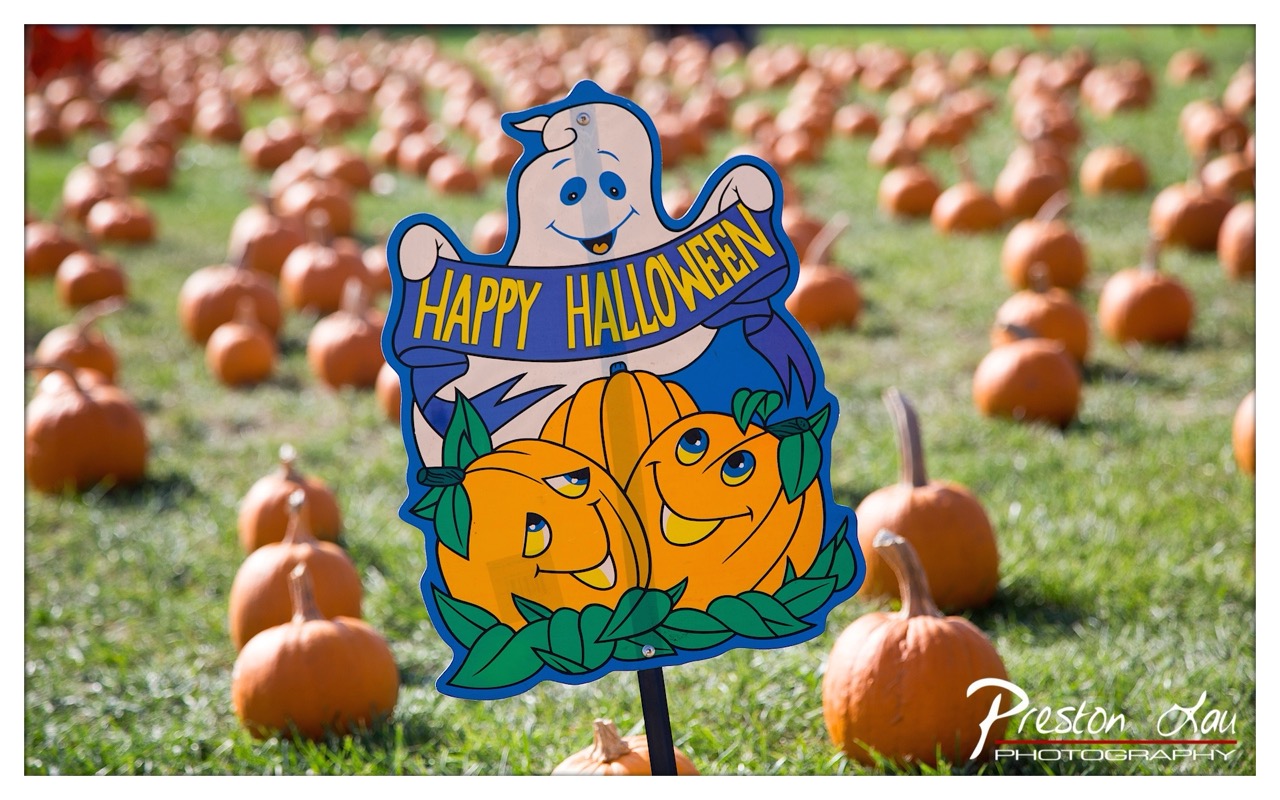

Pumpkin Patch Sentinel
Subject Rating: 7/10
Ah, behold the mighty guardian of the gourd garden! This image perfectly captures the autumnal spirit, featuring a cheerful Halloween sign front and center. Our primary subjects are a rather friendly-looking cartoon ghost, grinning widely as it holds a banner declaring "HAPPY HALLOWEEN" in bold yellow letters against a deep blue sky. Below the spectral pal are three pumpkins, one looking slightly grumpy (perhaps realizing its fate as a future jack-o'-lantern?) and the other two sporting excited grins and leafy green tendrils. The scene is set against the classic backdrop of a pumpkin patch, a sea of vibrant orange spheres stretching into the distance, blurred just enough to make our festive sign pop. It's a simple yet effective visual shout-out to the spooky season, setting a lighthearted and welcoming tone for any pumpkin patch visitor.
From a photographic standpoint, this shot employs a nice shallow depth of field, artistically blurring the rows and rows of pumpkins in the background into a warm, bokeh-filled tapestry. This isolation technique successfully draws the viewer's eye directly to the sign, which is perfectly sharp. The composition is decent, placing the sign slightly off-center, though a tiny adjustment could have centered it more strongly or pushed it further for rule-of-thirds placement depending on preference. The lighting is bright and seemingly from above, providing good illumination on the sign's front surface, though perhaps a slight fill flash could have lifted the shadows on the right side. The colors are punchy – the bright orange of the pumpkins and the blue/white/yellow of the sign contrast beautifully with the green grass, reinforcing the seasonal theme. A solid execution of highlighting a focal point within a busy, thematic environment.
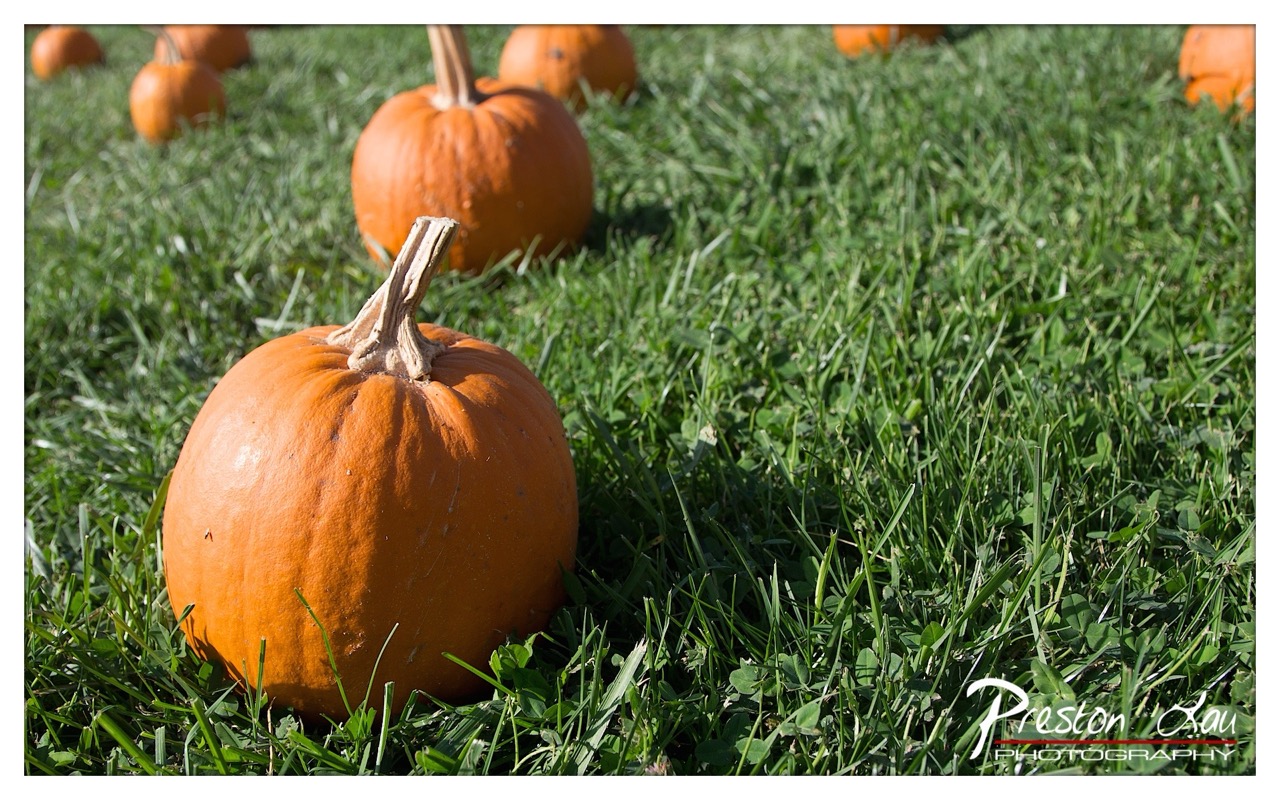

Title: Autumnal Blurr: A Pumpkin's Identity Crisis
Rating: 7/10
Ah, the quintessential autumn scene: a gathering of plump, orange pumpkins nestled amongst lush green grass. What's happening here? It seems we've stumbled upon a relaxed pumpkin convention, enjoying a sunny day out in the field. The mood is warm, natural, and distinctly autumnal, perfectly capturing that crisp, golden hour feel... except perhaps it's more mid-day sun. The main subject, a glorious specimen in the foreground, seems to be embracing its soft side, rendered in a gentle blur that makes you wonder if it's shy or simply hasn't had its morning coffee yet. Other pumpkins dot the background, adding context to this outdoor gathering, mostly receding into a pleasant bokeh.
From a photographer's perspective, the composition places the primary (albeit out-of-focus) subject in the lower left, creating a bit of an unbalanced frame with a large swath of sharply focused grass on the right. The lighting is bright and natural, beautifully illuminating the textures of the pumpkins and the varying shades of green. The color palette is classic fall, vibrant oranges against rich greens. The depth of field is quite shallow, effectively separating the layers but leading to the curious choice of focusing behind the main star. Was this an intentional artistic decision to emphasize the texture of the stem and background grass, or did the autofocus get distracted by a particularly charming clover? Regardless, it's a natural, outdoor shot that speaks to the season, even if the hero pumpkin decided to sit out the sharpness contest. The background hints at a wider scene, likely a full-blown pumpkin patch fiesta.
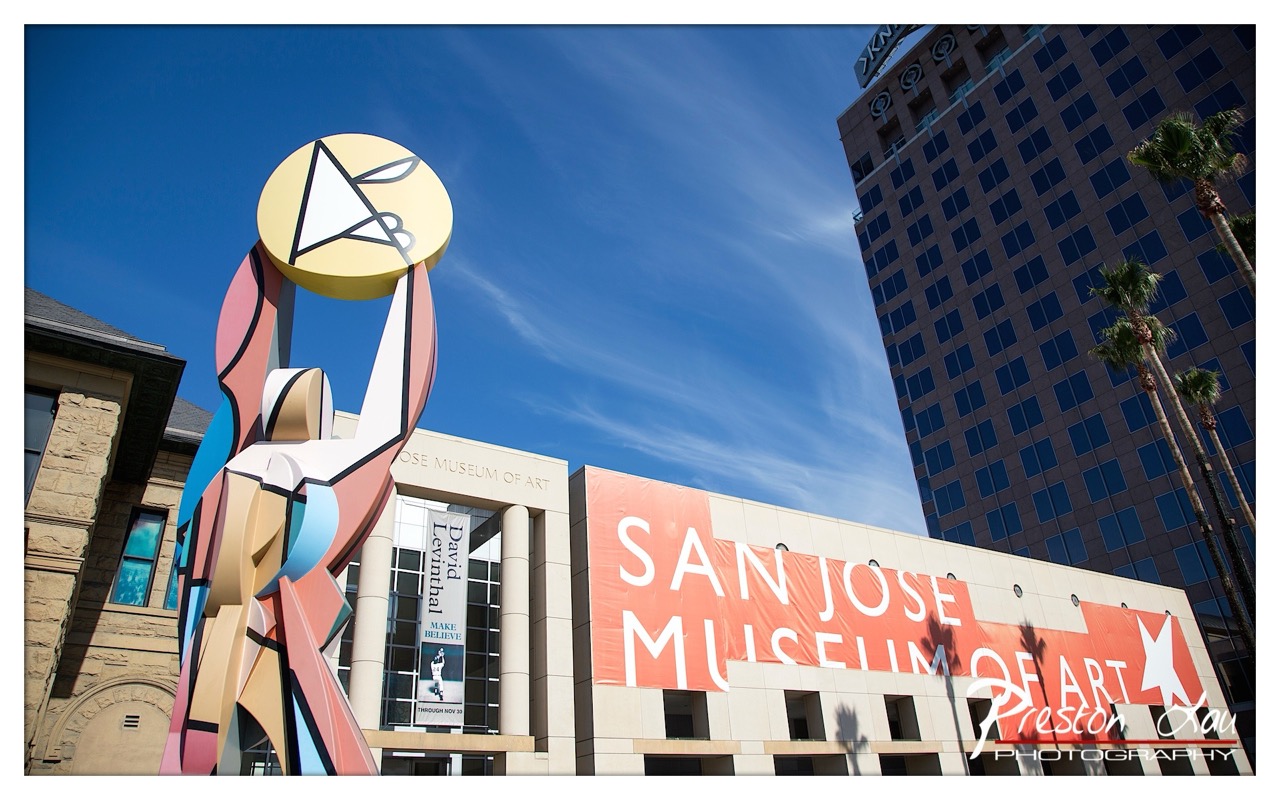

Guardian of the Gate: San Jose Museum of Art on a Sunny Day
Rating: Subject: 7/10
Well, hello there, Mr. Abstract Sculpture! Standing tall and colorful, you definitely steal the show, though perhaps not enough for a perfect score – maybe you need a little more dramatic flair, or perhaps fewer pigeons using your head as a perch? (None visible, but one can dream!) This image captures a very bright and sunny scene outside the San Jose Museum of Art, with the museum building proudly displaying its large, somewhat blinding orange banner that screams "ART!" Beyond the museum, a rather imposing modern high-rise looms, asserting its dominance over the skyline like a stern parent, flanked by a couple of stoic palm trees just trying to enjoy the sunshine. The mood is distinctly urban and artistic, a vibrant, sunny snapshot of culture and commerce coexisting under a brilliant blue sky with some rather fetching wispy clouds.
From a photographic perspective, this is a bold choice of angle! Shooting low gives the sculpture and buildings a sense of grandeur, making them feel quite monumental, but it also introduces some classic wide-angle perspective distortion, making that tall building lean back like it's reconsidering its life choices after seeing the museum's art collection. The composition places the vibrant sculpture as a key foreground element, leading the eye towards the museum entrance, while the large banner ensures you know exactly where you are. The lighting is classic harsh midday California sun – great for making the colors on the sculpture pop like a firework, but those deep shadows on the museum facade hide detail and create some rather unfortunate patchy areas. The contrast is high, which works for the graphic nature of the sculpture and banners, but challenges the dynamic range. The splash of color from the sculpture and the orange banner really contrast wonderfully against the more neutral architectural tones, adding visual energy. Overall, it's a dynamic shot that captures the scene effectively, though one might wish for softer light to tame those shadows and reveal more texture, proving that even in sunny California, perfect light is as elusive as finding a parking spot downtown. Plus, kudos to Preston Gau for capturing the moment, watermark and all!
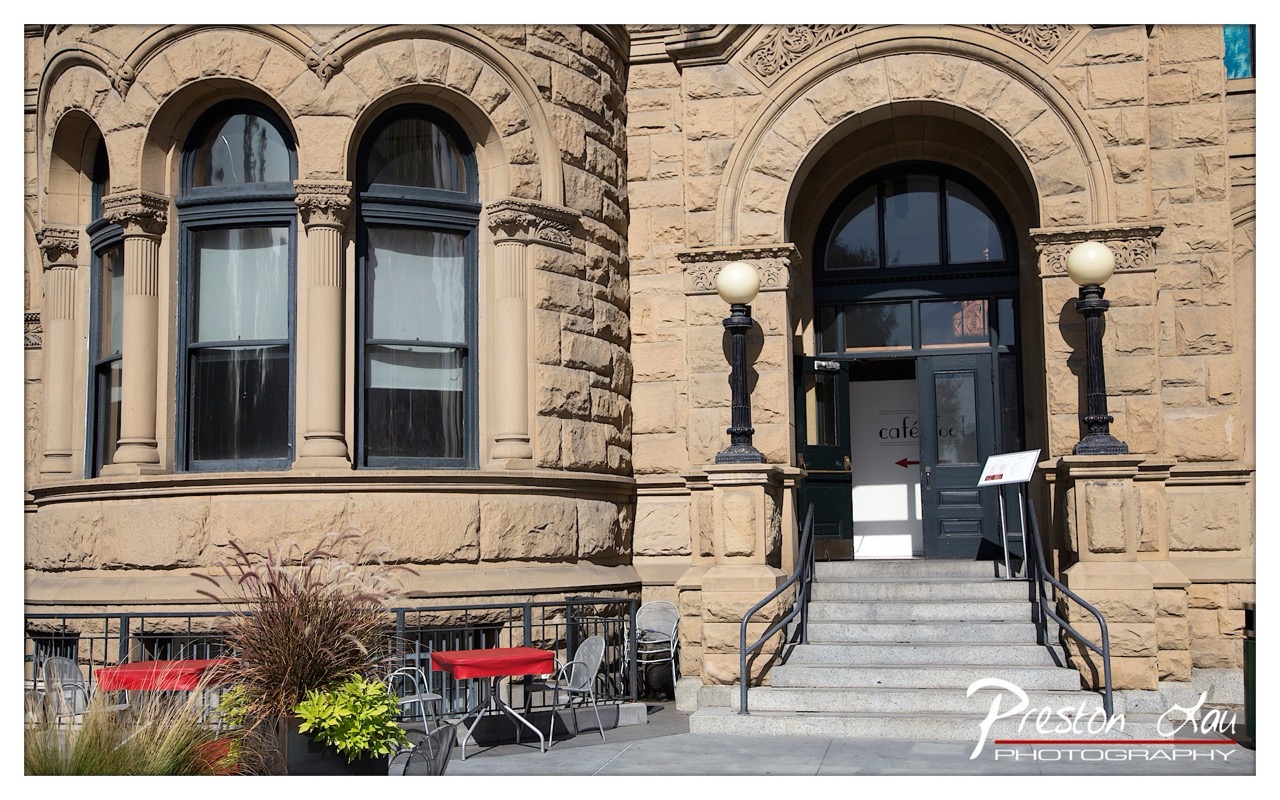

Historic Grandeur Meets Casual Brews
Rating: 8/10
This image captures the impressive facade of a grand old stone building, showcasing both its historical architectural details and its modern-day purpose as a cafe. On the left, a curved section features multiple arched windows supported by decorative columns, highlighting the intricate stonework and craftsmanship of a bygone era. To the right, a large arched entrance leads up a set of wide steps to a double door, clearly marked with a sign indicating "café". Two classic globe lamps flank the entrance, adding a touch of old-world charm. In the foreground, a small outdoor seating area with red-topped tables and metal chairs sits behind a railing, suggesting a welcoming spot for patrons to enjoy a drink or meal al fresco against the backdrop of the ornate building. The scene feels stately yet approachable, blending the weight of history with the simple pleasure of a coffee shop.
From a photographic perspective, the composition effectively splits the frame between the detailed window section and the inviting entrance, leading the eye upwards along the steps. The natural light is bright, casting clear shadows that accentuate the texture of the roughly hewn stone blocks and the intricate carvings around the arches. While the lighting is a bit direct, it manages to pull out the details without completely blowing out highlights. The color palette is dominated by the warm, earthy tones of the stone, which are nicely contrasted by the dark window frames, doors, and railings. The vibrant red tables in the foreground add a crucial pop of color and a contemporary touch, preventing the image from feeling too monochrome or stuffy. The prominent watermark certainly stakes a claim on the work, ensuring no one forgets whose keen eye framed this blend of architecture and cafe culture – perhaps humorously reminding us that even grand buildings require careful documentation.
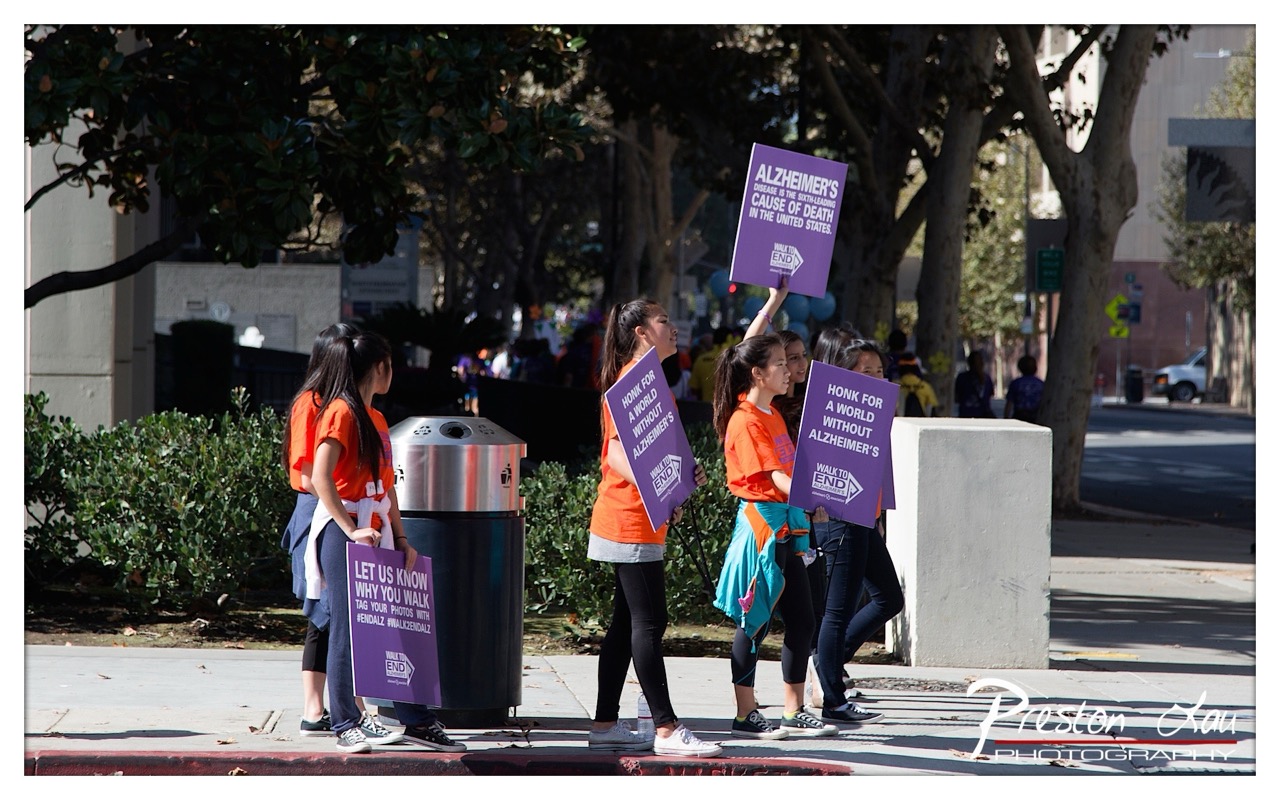

Purple Power for a Cause
Rating: 8/10
Rating the subjects in this frame, a solid 8 out of 10 for their dedication and sign-holding prowess. We see a group of young participants, predominantly female, donned in bright orange shirts and armed with prominent purple signs, taking part in an apparent "Walk to End Alzheimer's" event. The mood is one of purposeful engagement, conveying a sense of community and shared commitment to raising awareness for a significant health issue. Their signs aren't just props; they carry impactful messages like "Alzheimer's is the sixth-leading cause of death" and calls to action like "Honk for a world without Alzheimer's," making them crucial narrative elements. There's a large, modern trash receptacle nearby, perhaps conveniently located for post-walk snack wrappers, but let's be honest, it adds a touch of everyday reality to the scene – its aesthetic contribution rating: 4/10.
From a photographer's perspective, this shot captures a slice of the event's energy. Compositionally, the group is anchored left-of-center, balancing against the rather imposing concrete block on the right, creating some visual tension and framing the background street scene effectively. The lighting is classic harsh midday sun, creating strong shadows on the ground and potentially challenging highlights, though the vibrancy of the orange and purple colors manages to cut through the glare. Style-wise, it's a candid capture from an event, focusing on the participants and their message. The depth of field keeps the subjects sharp while letting the background trees and distant building provide context. It's a solid documentary shot that clearly communicates the purpose of the gathering, demonstrating the photographer's ability to frame a group and their visual messaging in a real-world environment, despite the sun trying its best to turn everyone into squinty silhouettes.
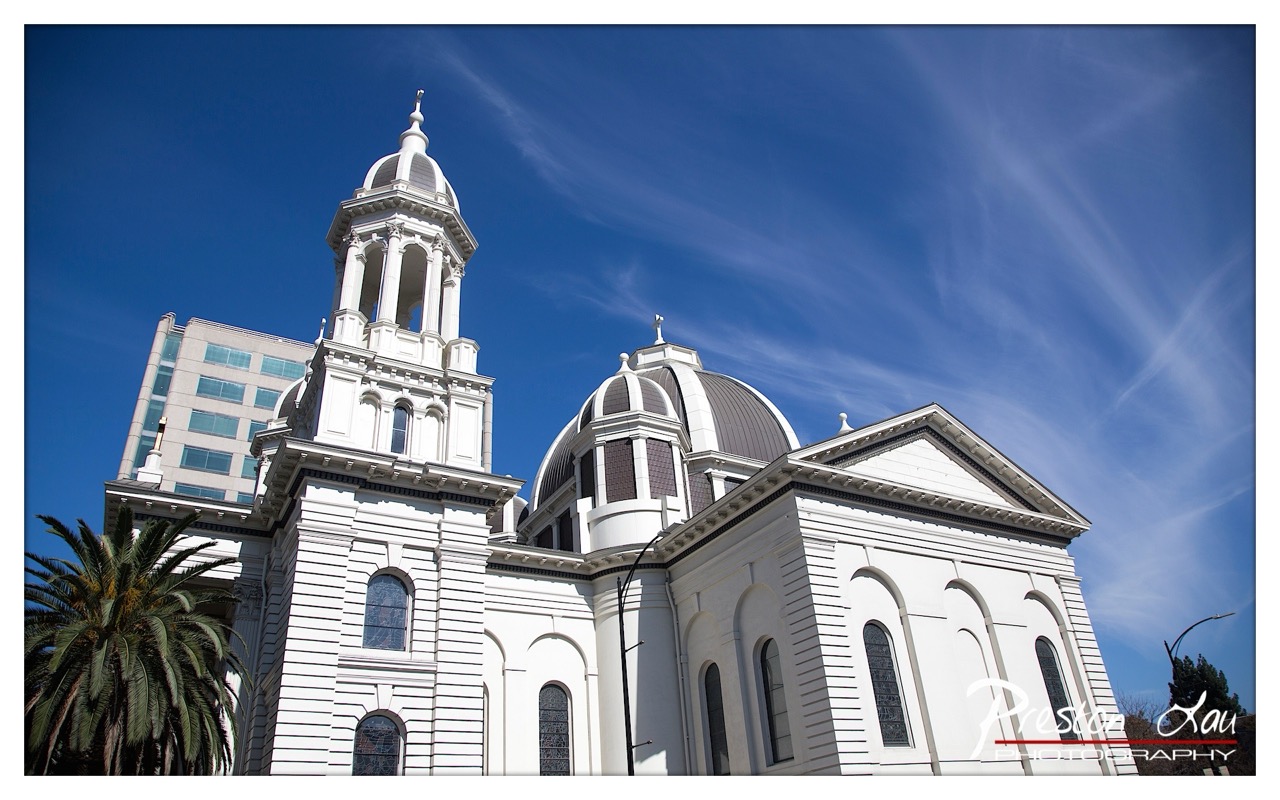

Architectural Harmony (and Disagreement)
Subject Rating: 8/10
Well, hello there, classic architecture trying its best to look majestic despite being slightly overshadowed by a modern glass box and photobombed by a rather enthusiastic palm tree! This sunny scene captures a beautiful white church building with its impressive tower and dome reaching for a vibrant blue sky streaked with wispy clouds. It's a bright day, highlighting the intricate details of the church's facade – the arched windows, Corinthian columns on the tower, and the pediment above the main entrance. In the background, a beige modern office building with reflective windows stands as a stark contrast, peeking out awkwardly from behind the historical structure like a shy giant. The overall mood is bright and clear, perhaps a little conflicted given the architectural neighbors, but undeniably sun-drenched.
From a photographic perspective, the composition employs a dramatic low angle, which effectively emphasizes the height and grandeur of the church tower and dome, giving it a sense of scale against the wide-open sky. The diagonal lines created by the tilt of the building add dynamic tension, preventing the shot from feeling static. Lighting is typical of a bright sunny day – strong and directional, creating deep shadows and highlighting the textures of the white stone, though perhaps pushing the highlights a touch on the bright white surfaces. The color palette is dominated by the striking contrast between the deep blue sky and the brilliant white building, punctuated by the green of the palm and the darker tones of the dome and the modern building. It's a classic juxtaposition shot, showing how old and new coexist in urban landscapes. Just try not to get blinded by the sheer whiteness or tripped up by that pesky street light pole on the right – capturing architecture in full sun is always a balancing act! And let's not forget the prominent watermark, just in case you were thinking of framing this masterpiece yourself.
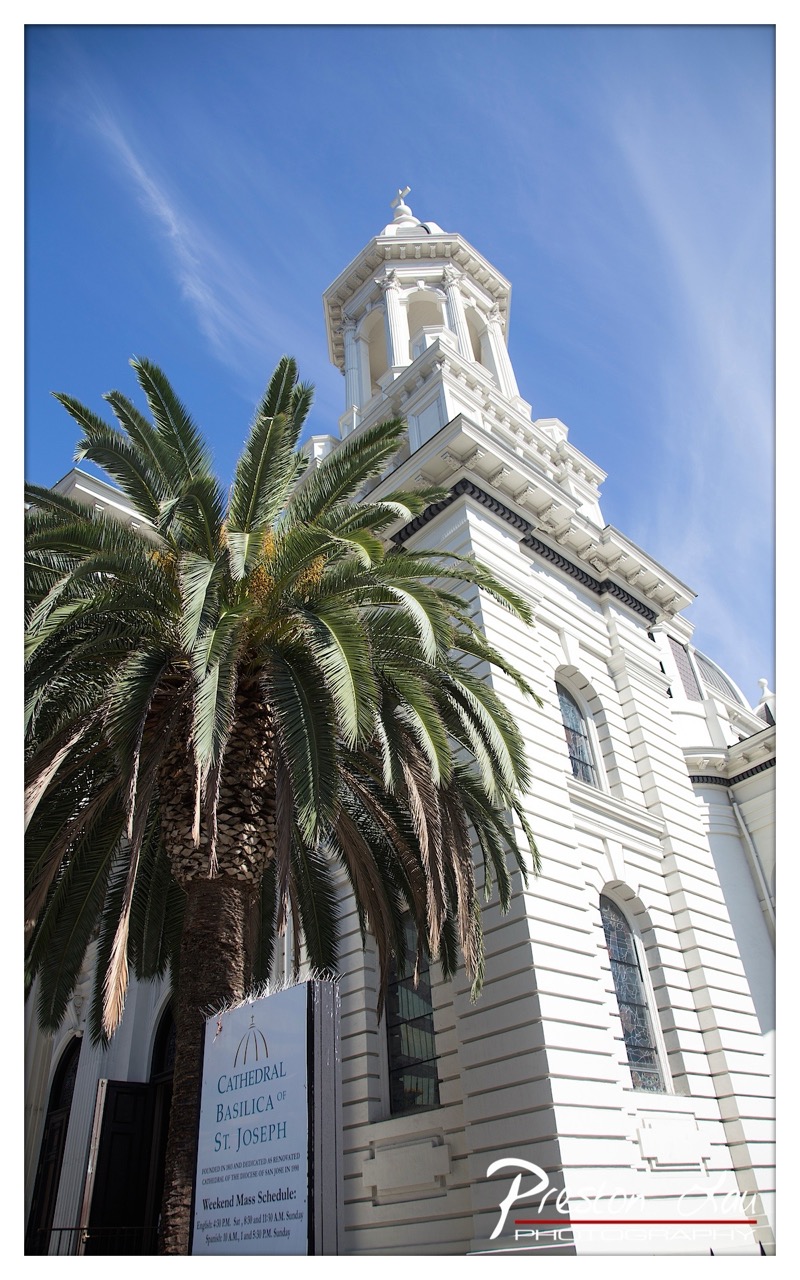

Cathedral of Contrast
Subject Rating: 8/10
Behold, the magnificent Cathedral Basilica of St. Joseph, bravely attempting to share the frame with a rather enthusiastic palm tree under a decidedly bright blue sky. The scene captures a sunny day, lending a bright, almost cheerful, but perhaps slightly too harsh light to the grand architecture. It's a classic case of "Look, a cool building! And a tree! Let's get them both in!" The mood is one of serene grandeur mixed with the casual vibe of a Californian day. Pertinent objects include the towering white cathedral with its intricate details, the leafy, dominant palm tree, and a sign helpfully informing us exactly what we're looking at, just in case the combination of basilica and palm tree wasn't obvious enough for San Jose.
From a photography perspective, this shot certainly leans into the low-angle, wide-view approach, giving the building a sense of imposing height, though at the cost of some vertical distortion – it feels like the building is leaning back for a sun tan. The composition places the large palm tree squarely on the left, creating an interesting, if slightly unbalanced, juxtaposition with the hard lines of the architecture. Lighting is the classic midday challenge; the bright sun, while making the sky pop, creates stark shadows and pushes the brilliant white of the building perilously close to pure white, losing some detail. The color palette is vibrant: the intense blue of the sky contrasts nicely with the green of the palm and the white of the church, creating a visually striking image, though one might wish for the softer light of the golden hour to truly bring out the textures of the building. It’s a classic travel photo – capturing the essential elements, perhaps without the polish of a dedicated architectural shoot, complete with a watermark staking its claim, just in case you thought you'd snapped this sunny, leaning basilica yourself.
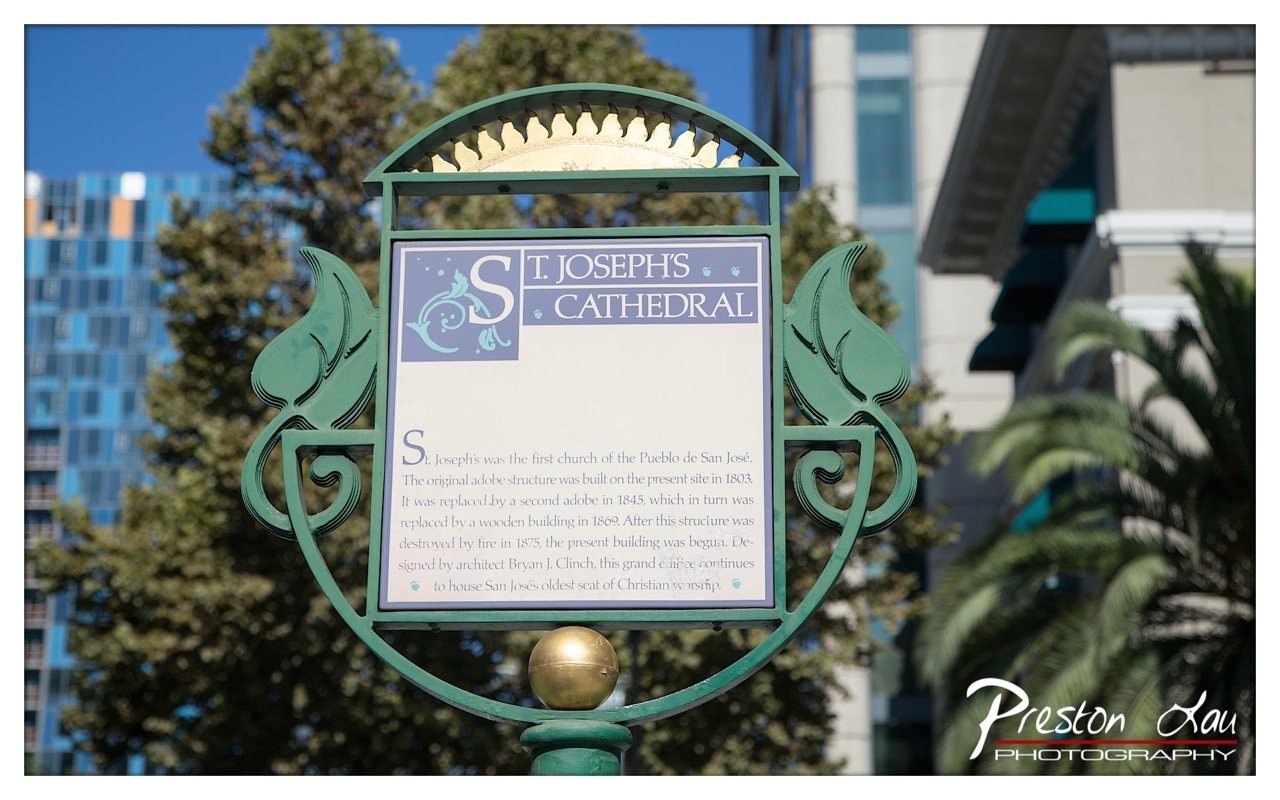

Sign of the Times (and History)
Rating: 7/10
Ah, the glamorous life of a photographer: capturing riveting shots of… signs! This particular sign, elegantly crafted in green metal with whimsical leaf-like adornments and a cheerful sunburst crown, stands proudly displaying the history of St. Joseph's Cathedral. It’s giving us a potted history lesson, detailing the building's various iterations since 1803, which frankly, is more drama than my last family gathering. The mood is decidedly informative, aiming to enlighten passersby, though the tight crop and prominent foreground treatment elevate it slightly beyond just a functional marker. Behind our historical hero, a slightly out-of-focus world unfolds – a mix of modern blue and orange buildings peeking through lush green trees, all bathed in bright, clear daylight. The golden sphere at the base adds a subtle touch of class, hinting that this isn't just *any* sign; it's a sign with aspirations.
From a photographic perspective, this shot leans heavily on subject isolation, using a relatively shallow depth of field to blur the background into pleasant bokeh, ensuring the sign remains the star of the show. The composition is straightforward, placing the sign squarely in the center, leaving little room for compositional controversy (or excitement). Lighting is a bit harsh, typical of midday sun, creating some noticeable contrast and highlights, particularly on the metallic elements, but thankfully, the text on the sign remains perfectly legible – which, for a photo *of* a sign, is rather crucial. The colors are vibrant, with the sign's green and the sky's blue providing a nice contrast. The photographer's watermark sits confidently in the corner, a clear declaration of ownership over this momentous capture of civic information. It’s a solid, well-executed photo of its subject, proving that even historical markers deserve their moment in the spotlight.
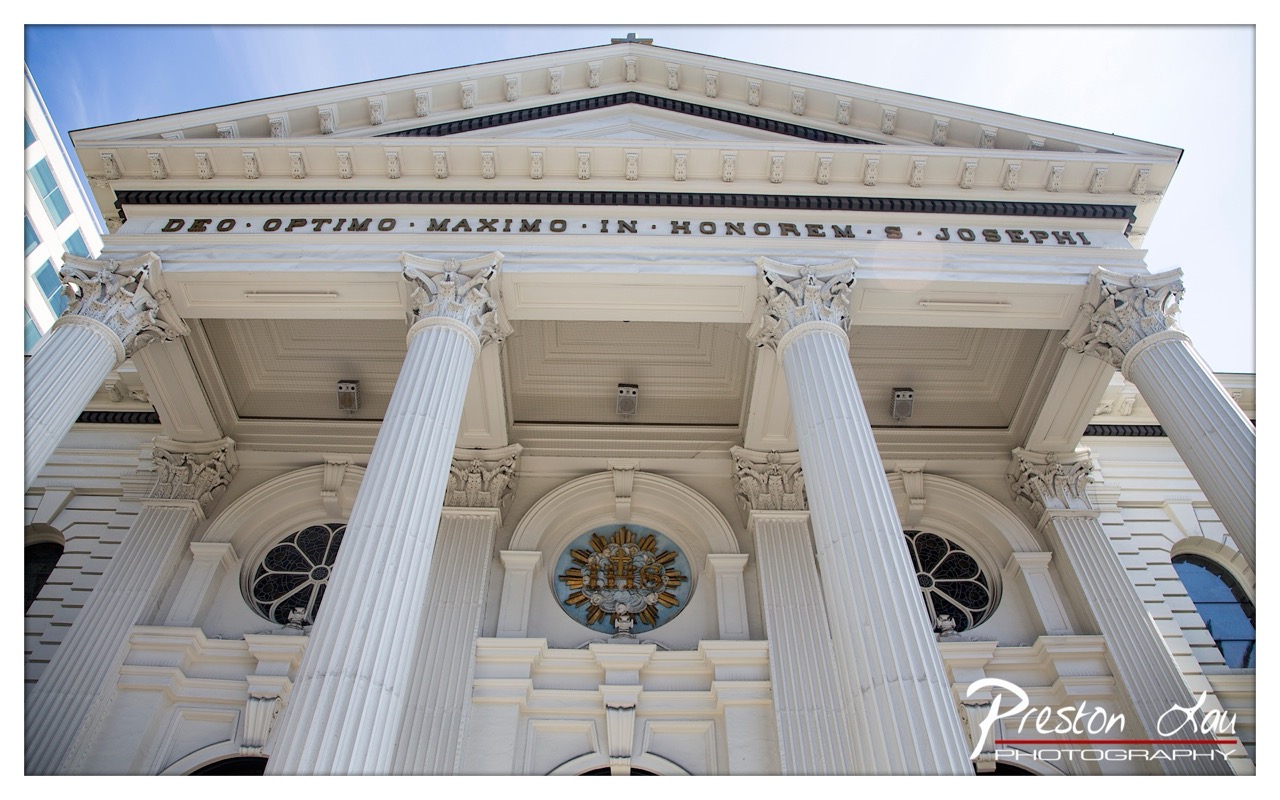

Church Facade Grandeur
Subject Rating: 8/10
Well hello there, Mr. Imposing Edifice! This shot gives us the full, neck-craning experience of standing before a rather grand white church facade. The subject, undeniably majestic, features a row of towering, fluted columns with elaborate Corinthian capitals supporting a weighty entablature and pediment. The Latin inscription "DEO OPTIMO MAXIMO IN HONOREM S. JOSEPHI" ("To God, Best and Greatest, In Honor of St. Joseph") is clearly visible, setting a historical and reverent tone. Below the portico, arched openings frame windows, including a prominent central medallion displaying the IHS Christogram surrounded by golden rays and symbols, flanked by smaller rose windows. The low-angle perspective makes the building feel immense, almost overwhelming, conveying a sense of awe and architectural power under a relatively clear sky, with a hint of a modern building on the left adding urban context.
From a photographer's standpoint, embracing the low angle was the right call to capture the scale, even if it means playing hopscotch with perspective distortion – a classic architectural challenge! The bright daylight is both a blessing and a curse; it effectively lights the intricate details on the white stone and capitals, but you can almost feel the glare. The simple white-against-sky color scheme keeps the focus squarely on the form and texture of the building, allowing the details to shine. It's a traditional approach to architectural photography, aiming for a clear, impressive record of the facade. The composition uses the columns as strong vertical elements and framing devices, leading the eye up the structure. A solid, well-executed shot that clearly showcases the building's key features, complete with the photographer's stamp, just in case you were wondering who braved the sore neck for this view.
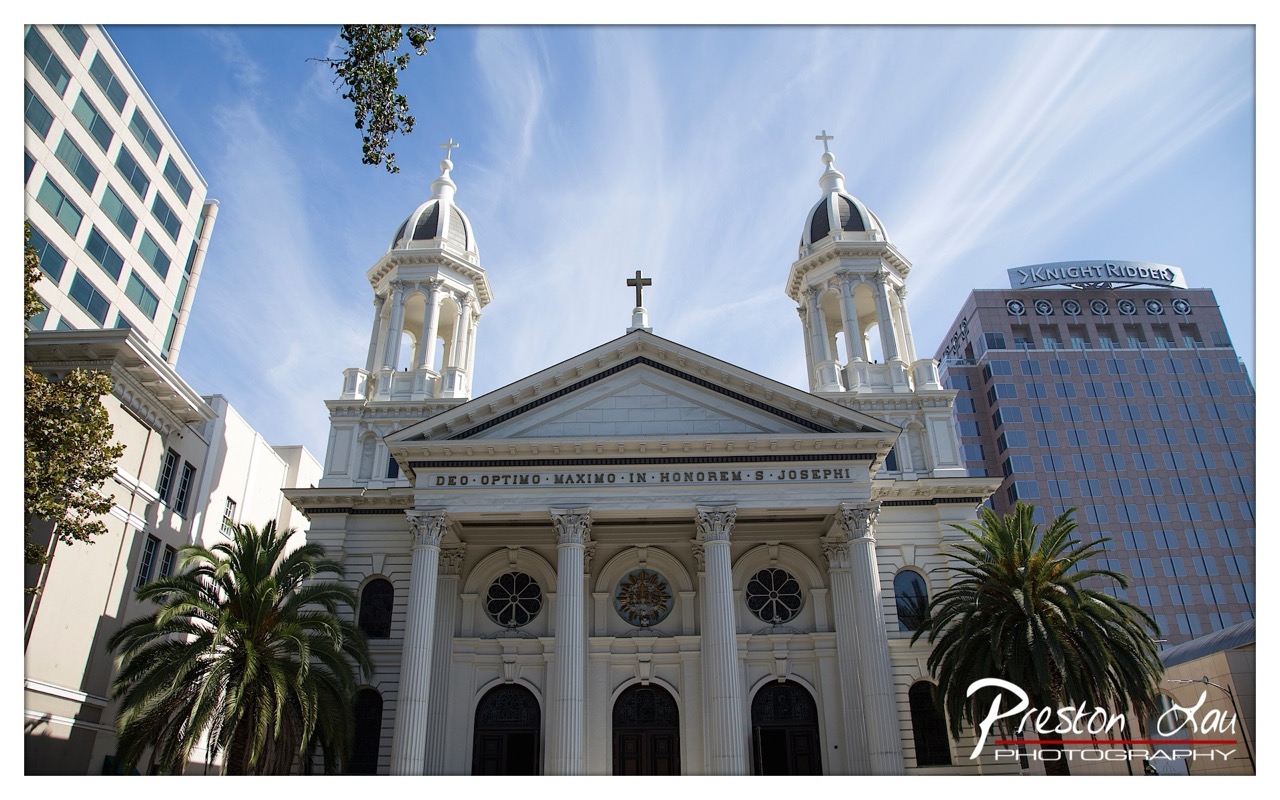

Title: Holy Skew: San Jose Cathedral Meets Wide-Angle Lens
Subject Rating: 8/10
In this dynamic capture of downtown San Jose, the magnificent St. Joseph's Cathedral takes center stage, proudly showcasing its classical architecture with twin spires and ornate facade under a bright blue sky streaked with dramatic cirrus clouds that seem to radiate from the sun. Flanked by towering modern office buildings, including the recognizable 'Knight Ridder' structure on the right, the image starkly contrasts the enduring grandeur of faith with the sleek, vertical lines of contemporary commerce. Lush green palm trees frame the scene, adding a touch of California warmth and a hint of tropical relief to the bustling urban environment. It's a vivid snapshot of old meeting new, where sacred history coexists, somewhat awkwardly, with the present-day concrete jungle and its corporate inhabitants.
From a photographic standpoint, this shot boldly employs a wide-angle lens, resulting in a composition that's as dramatic as it is distorted. The church itself seems to be leaning back ever so slightly, while the unfortunate building on the left appears to be auditioning for a role in a disaster movie, performing an impressive, if concerning, tilt. It's a perspective choice that turns the urban landscape into something straight out of an Escher drawing, if Escher designed churches and office towers with structural issues. While the strong sunlight beautifully illuminates the church's details and creates striking highlights in the sky, enhancing the majestic feel of the clouds, the pronounced distortion makes the scene feel just a little bit tipsy. Adding a flourish, the photographer's watermark is rather prominently placed in the bottom right, like a signature strategically covering a piece of the puzzle, specifically a rather nice-looking palm tree. It's a strong subject captured with energetic lighting, but the wide-angle fun house mirror effect gives the viewer a slightly wobbly sense of place.
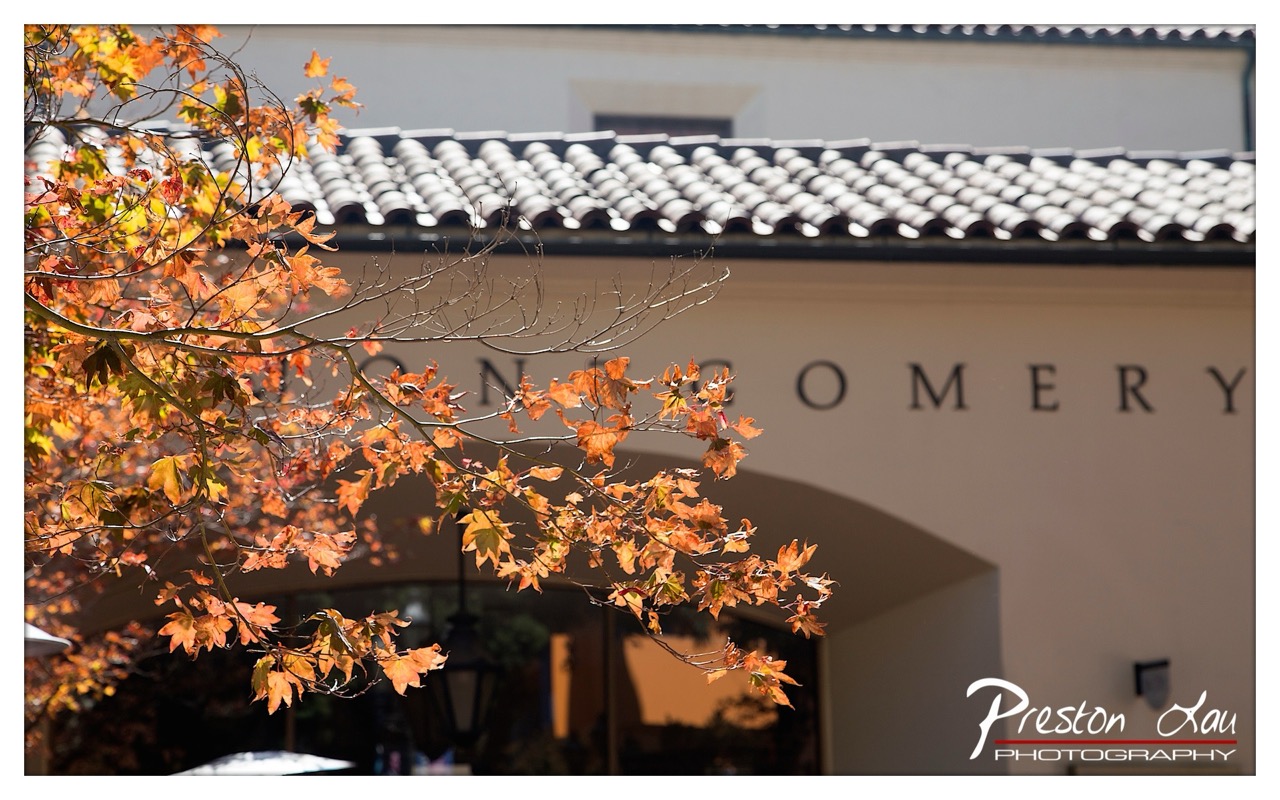

Autumn's Orange Curtain
Subject Rating: 8/10
Ah, autumn, the season where trees decide to wear their most flamboyant outfits and stand right in front of anything you might be trying to photograph. In this delightful scene, a cascade of brilliant orange and yellow leaves takes center stage, creating a vibrant, sun-drenched curtain in the foreground. Behind this leafy spectacle, a stately building peeks through, complete with a classic tiled roof catching the light and a hint of a wall bearing the somewhat enigmatic letters "O MERY". It’s like a botanical mystery novel where the main character is the tree, and the plot revolves around whether we'll ever see the full name of the building. The composition is all about embracing the chaos of nature interrupting architecture, giving the image a feeling of warmth and seasonal transition, even if the building is probably muttering something about personal space.
From a photographic perspective, this shot masterfully utilizes the strong directional light, likely low autumn sun, to backlight the leaves, making their colors intensely saturated and creating beautiful highlights. This dramatic lighting also adds lovely texture to the roof tiles in the background. The shallow depth of field throws the building into a soft, pleasing blur (bokeh), effectively isolating the sharp, colorful leaves as the primary subject. The warm color palette is quintessentially autumn, evoking feelings of coziness and change. It's a classic approach to capturing the beauty of fall foliage, using natural elements to frame the scene and focusing on the play of light and color, even if it means sacrificing a clear view of the background 'O MERY' building.
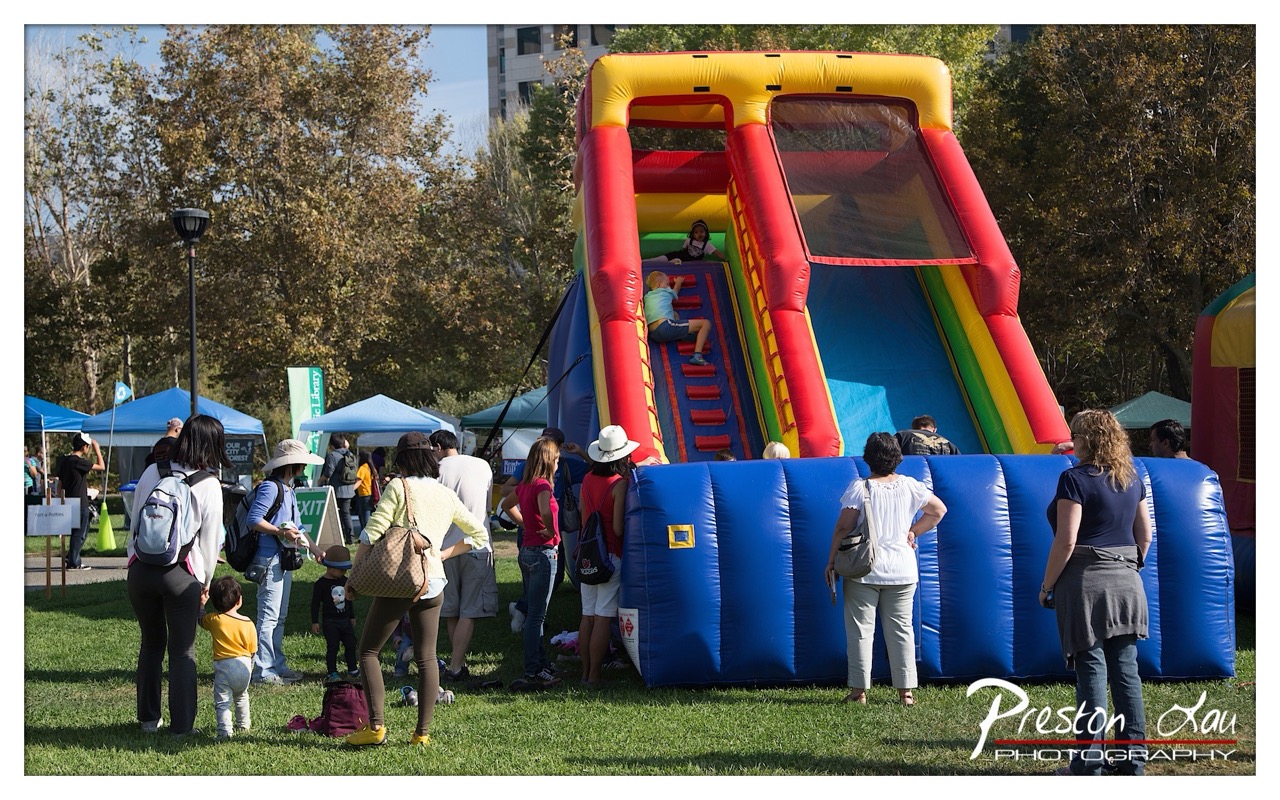

Event Fortress Fun
Rating: 7/10
Welcome to the battlefield of fun, dominated by this colossal inflatable fortress! The main subject, a vibrant red, yellow, and blue bouncy castle slide, towers over the scene, promising airborne adventures. Kids are actively engaged, with one scaling the steps and another perched at the top, contemplating the descent. Surrounding this bouncy beast are clusters of adults, some casually observing, others seemingly plotting their next snack acquisition from the nearby tents visible in the background. The scene is set in a sunny, grassy park, flanked by mature trees and blue tents, creating a lively, community-event vibe. The mood is decidedly upbeat and energetic, capturing the essence of a family fun day out.
From a photography perspective, the composition places the massive inflatable slightly off-center, drawing the eye into the heart of the action, although the large blue foreground barrier is a bit like a friendly, squishy wall separating us from the true inflatable chaos. The lighting is bright and sunny, which makes the vibrant colors of the inflatable pop, but also creates some strong contrasts and shadows typical of midday sun – maybe next time, aim for that golden hour glow? The subject matter is classic event photography, capturing people enjoying leisure activities. It's a dynamic scene with multiple layers of activity, although perhaps a lower angle might have made the inflatable feel even more immense. The watermark serves as a gentle reminder of the photographer's mastery over capturing these moments of bouncy mayhem.
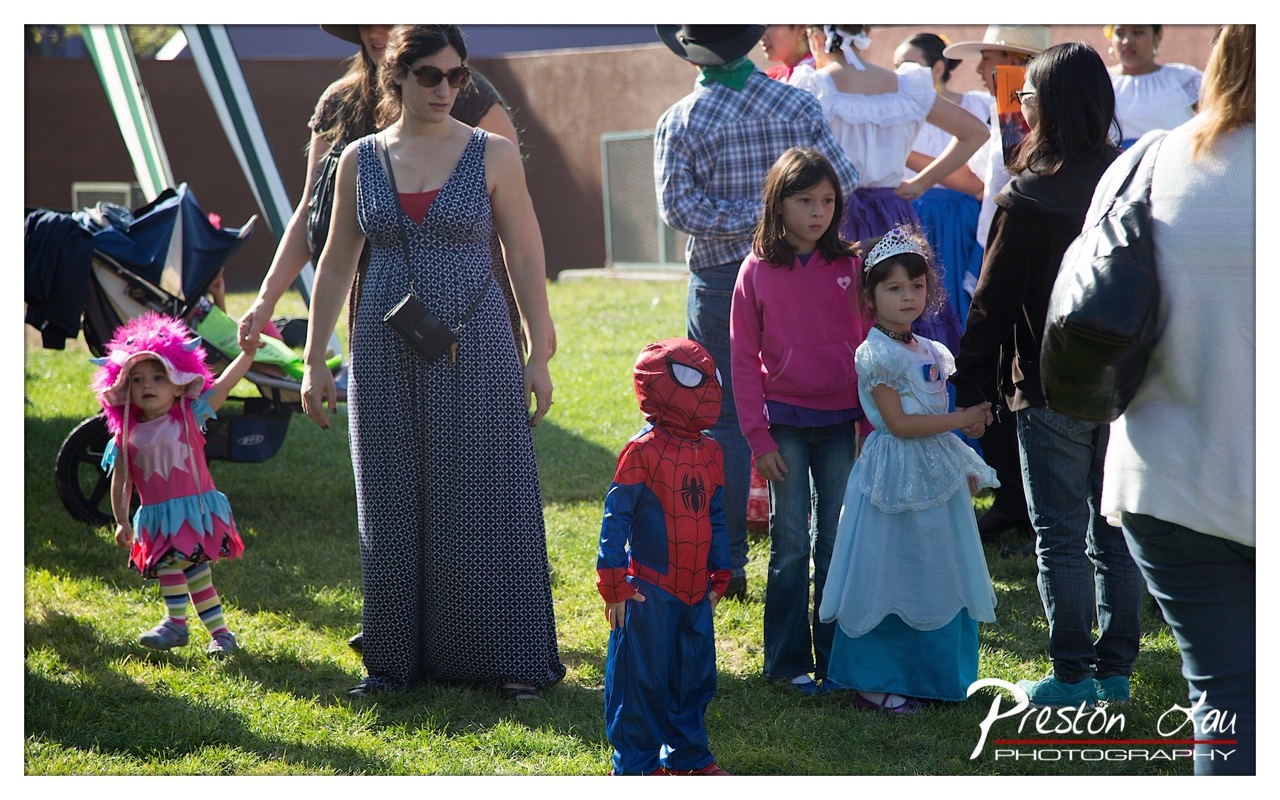

Costumed Characters and Candid Captures
Subject Rating: 8/10
This image captures a snippet of what appears to be a lively outdoor event, possibly a fair or festival, focusing on a group of individuals, notably several children in costumes. The atmosphere feels somewhat festive, perhaps even a touch whimsical given the attire, yet grounded in the reality of simply standing around. We see a young Spider-Man standing stoically center-frame, flanked by a tiny princess in a flowing blue gown and another child in a bright pink, fluffy creature costume holding hands with a woman in a polka-dot jumpsuit. In the background, other attendees, some seemingly in traditional dress, add depth to the scene, suggesting a larger cultural gathering is underway. A baby stroller sits on the left, packed with gear, hinting at the practicalities of attending such an event with young ones. The overall tone is candid and observational, freezing a moment in the flow of the day.
From a photographic perspective, the composition feels slightly accidental, catching subjects mid-scene rather than being deliberately posed. The framing is a bit tight on the left, awkwardly cropping the stroller, and the right edge cuts off subjects abruptly. The harsh midday sun creates strong contrasts, casting deep shadows on the grass and faces, which, while lending a sense of bright reality, isn't the most flattering light for portraiture. The depth of field isolates the immediate foreground subjects somewhat, but the background remains busy enough to be slightly distracting, pulling the eye with its various colors and forms. The vibrant colors of the children's costumes provide pops of interest against the more muted tones of the adults and background, but the overall scene could benefit from softer lighting to enhance the details and mood. It's a true documentary shot – capturing the moment as it happened, complete with its photographic imperfections and authentic charm.
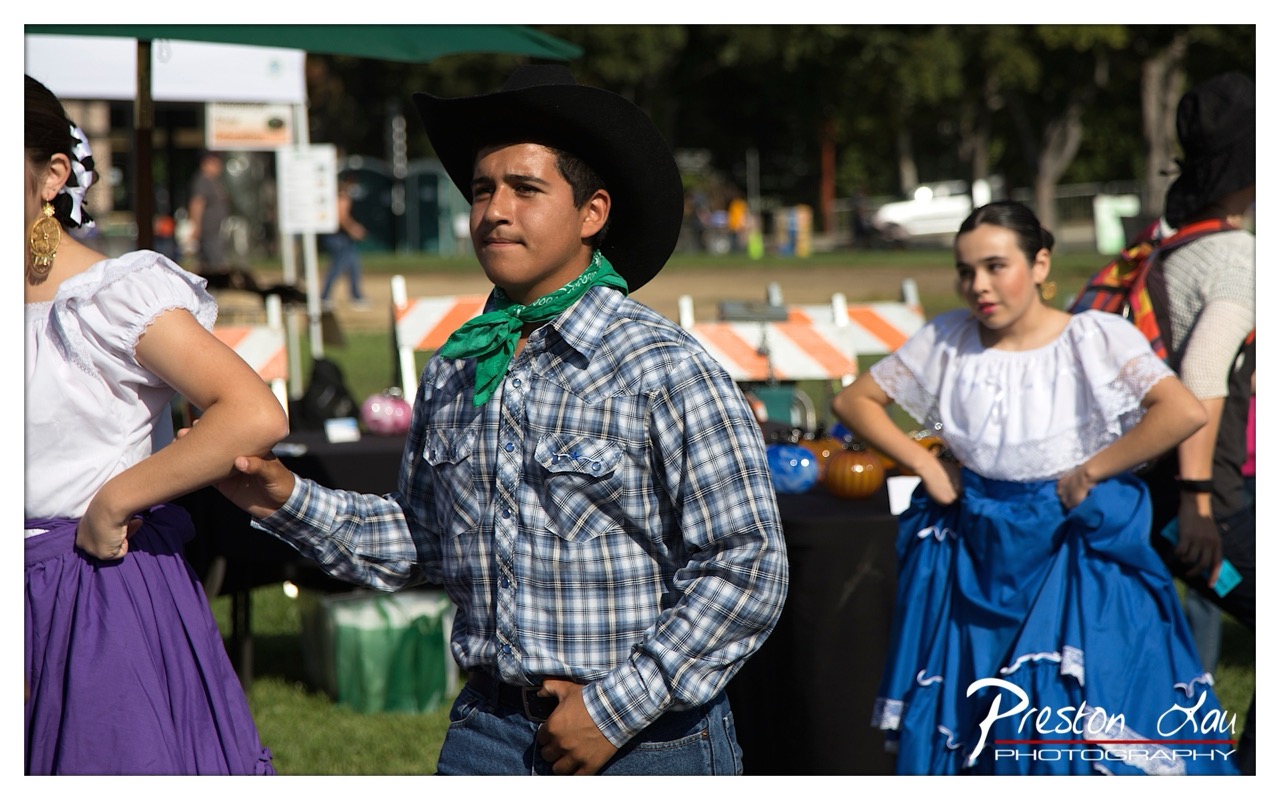

Title: The Plaid Cowboy and the Skirt Symphony
Rating: 7/10
Here we have a vibrant snapshot of a cultural performance, likely folkloric dance, where the central figure, a young man in a classic cowboy hat, blue plaid shirt, and bright green bandana, appears intensely focused on his steps. Flanked by female dancers in voluminous, flowing skirts – one in purple on the left (mostly cropped) and one in bright blue on the right – the image captures a dynamic moment mid-performance. The mood is energetic and festive, reflecting the spirit of the event, possibly at an outdoor festival or gathering, indicated by the tents and blurred crowds in the background. Note the delightful detail of the dancer on the left's massive gold earring, a true statement piece, and the interesting collection of colorful glass pumpkins or ornaments visible on a table behind the dancers, adding a quirky touch to the scene.
From a photographic perspective, the composition uses the three figures to create a diagonal line of action, although the dancer on the far left being significantly cropped feels a bit awkward. The shallow depth of field effectively isolates the performers from the busy background, putting the focus squarely on the dance. The natural light is bright, perhaps a little harsh on the faces, but it nicely illuminates the vibrant colors of the costumes. The shutter speed seems appropriate to freeze the motion of the dancers without blurring them, though capturing the full sweep of the skirts is always a challenge. The subject matter is compelling, showcasing cultural heritage, and the central figure's serious expression adds character. While the cropping isn't perfect, and the watermark is prominent, it's a lively capture that conveys the energy of the performance.
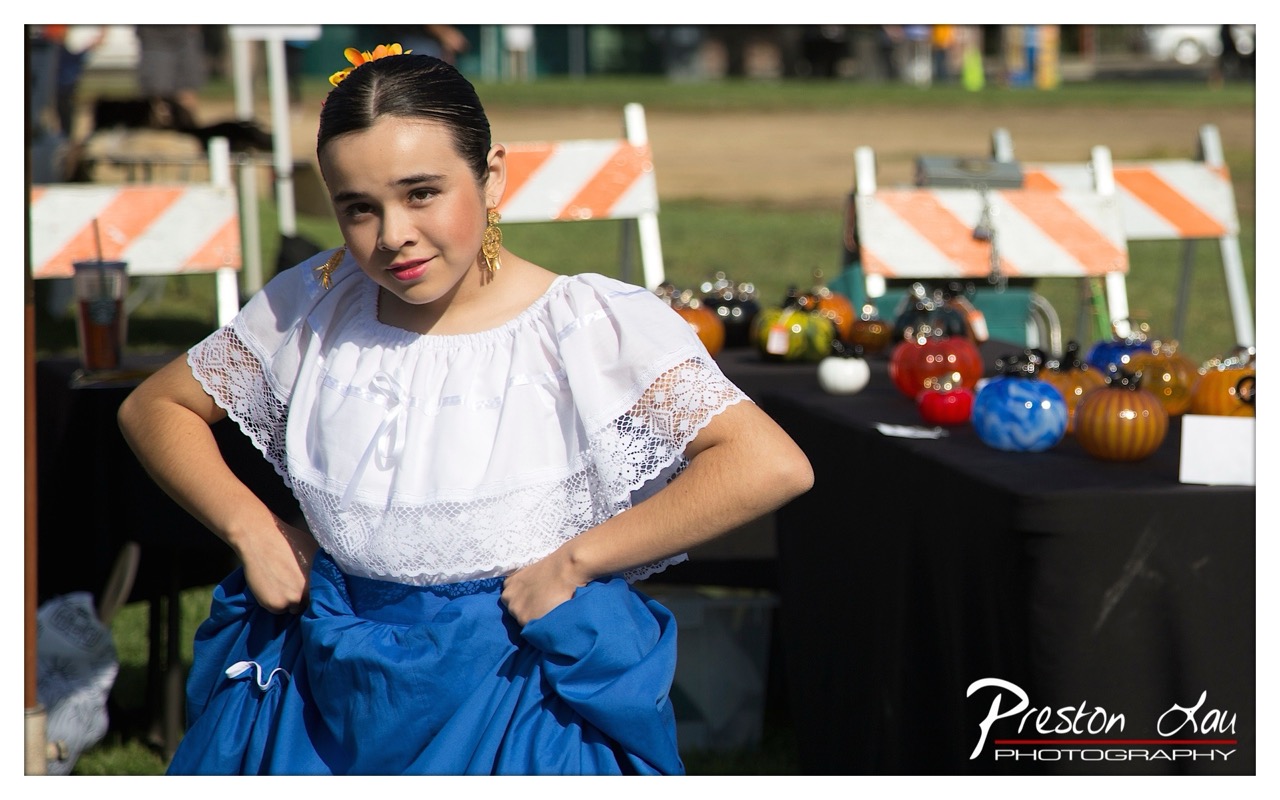

Capturing Culture and Craft
Subject Rating: 9/10
This vibrant image showcases a young woman, looking directly at the camera with a confident pose, dressed in traditional attire. Her white peasant blouse, adorned with intricate lace detail on the sleeves and hem, contrasts beautifully with her flowing, bright blue skirt. With her hands lightly gripping the fabric of her skirt, she seems poised, perhaps mid-performance or ready to dance, an orange flower adding a cheerful pop of color to her neatly styled hair, complemented by ornate gold earrings. The mood is lively and cultural, a snapshot of a moment at what appears to be an outdoor festival or market, celebrating heritage and perhaps craftsmanship, judging by the colorful glass pumpkins artfully displayed on a table behind her.
From a photographic standpoint, the composition places the subject slightly left of center, effectively using the rule of thirds to draw the eye to her expressive face. The photographer employed a shallow depth of field, rendering the background in a soft, pleasing blur which isolates the subject beautifully, making her stand out against the busy scene. The lighting is natural and bright, highlighting the textures of her clothing and the shine in her hair, though it might be a touch harsh on her face. The background, while blurred, provides context with orange and white barriers and a table laden with what look like artisanal glass pumpkins, adding visual interest and hinting at the nature of the event. The vibrant colors of her dress and the background objects are well-captured, creating a cheerful and inviting image, complete with the photographer's signature watermark claiming this colorful catch.
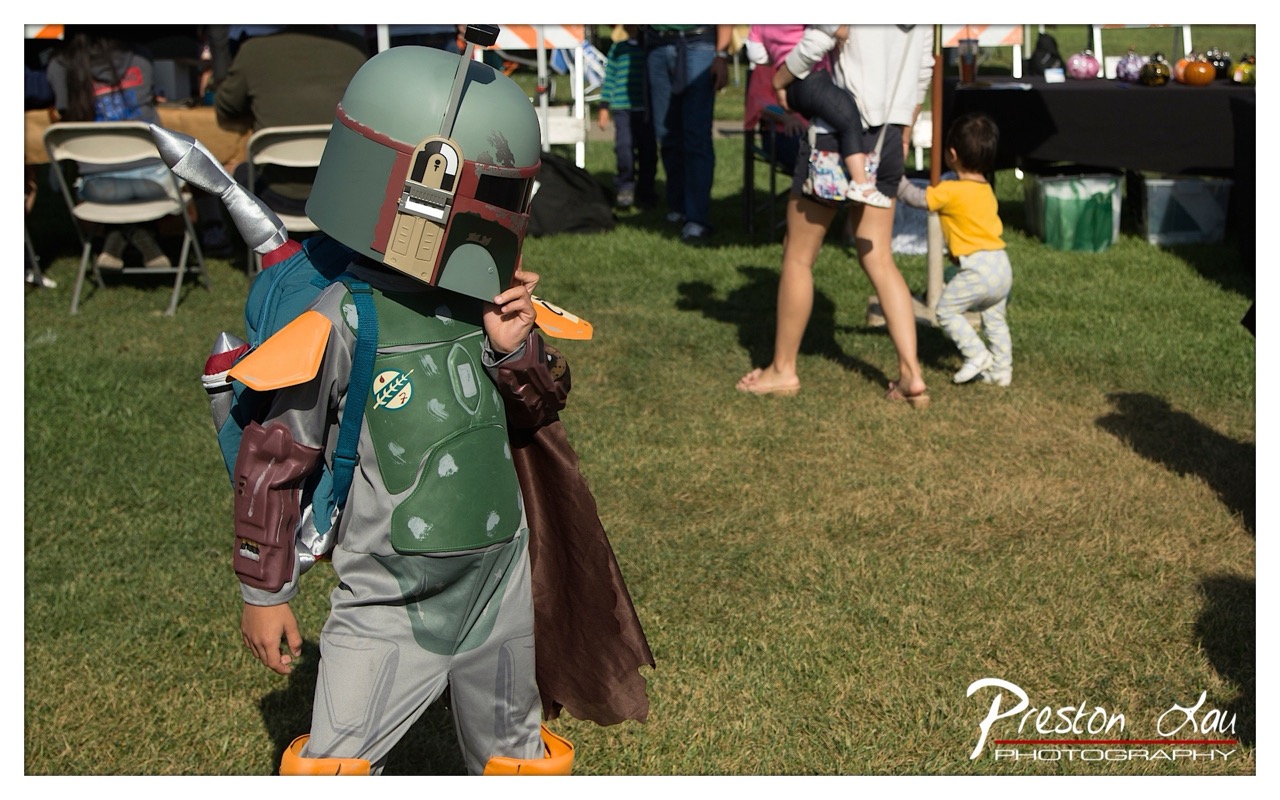

Bounty Hunter on Patrol
Rating: 9/10 (for the sheer coolness of the subject)
Here we have a pint-sized mercenary, fully kitted out in what appears to be a surprisingly detailed Boba Fett costume, complete with helmet, chest plate, and flowing cape. He's standing guard (or perhaps just figuring out how to see through the helmet) amidst the decidedly less epic backdrop of an outdoor community event. While the background is a blur of milling adults, folding chairs, and a table piled with vaguely round objects, our little bounty hunter remains the undisputed star, lending an air of playful, slightly misplaced sci-fi adventure to an otherwise mundane scene. The mood is light and perhaps a touch whimsical, capturing that moment of childhood immersion in fantasy despite the everyday reality surrounding them.
From a photographic standpoint, the composition wisely places the subject off-center, using a shallow depth of field to beautifully isolate the detailed costume against the blurry background, which conveniently hides the identity of the less-than-galactic denizens. The natural lighting seems adequate, highlighting the green and grey of the armor, although the contrast suggests it might be a bright day creating some harsh shadows elsewhere in the scene (notice the elongated shadows on the grass to the right, like specters of less photogenic subjects). The color palette is dominated by the greens of the grass and costume, accented by the helmet and cape, creating a visually appealing foreground. The photographer's watermark proudly sits in the bottom right corner, claiming this moment of adorable galactic conquest. It's a solid candid capture, prioritizing the character and fun of the moment over a pristine, controlled setup, perfectly suited for documenting an event like this.
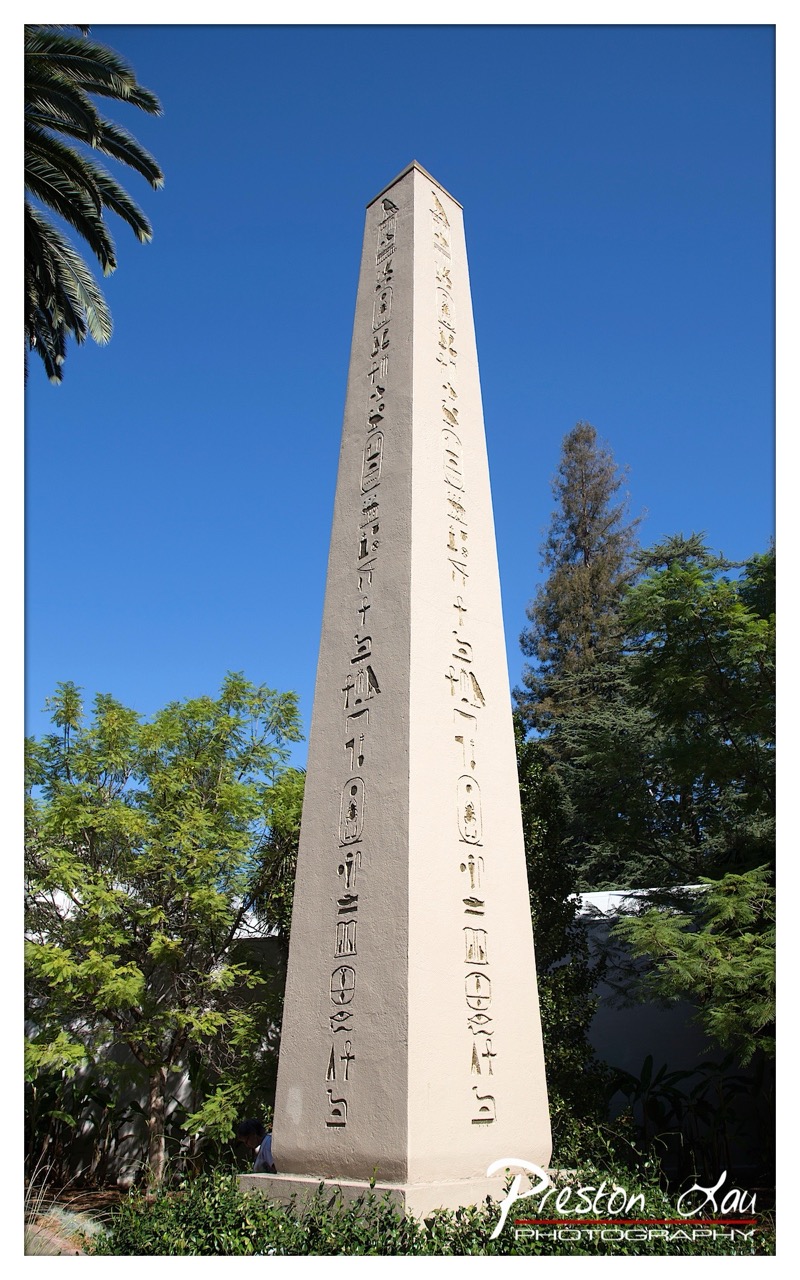

## Obelisk in the Sunshine: A Tale of Ancient Stone and Modern Shrubbery
Rating: 7/10
This shot features a striking obelisk, its sides adorned with what appear to be hieroglyphs, standing tall against a vivid blue sky. It’s a subject with inherent grandeur, rated a 7/10 because while the monument itself is impressive, its placement amidst what looks like a rather well-maintained suburban garden adds a touch of unexpected cognitive dissonance. What's happening? The obelisk is simply... existing, basking in the California-esque sunshine, silently pondering its potential relocation from ancient Egypt. A lone figure is semi-hidden in the bushes at its base, perhaps attempting to decipher a forgotten pharaoh's grocery list, or just taking a break from mowing the lawn. The mood is sunny and clear, leaning more towards historical novelty than ancient mystery, a serene day out with a very large pointy rock.
From a photographic standpoint, the composition employs a low angle which effectively accentuates the obelisk's height, allowing it to pierce the bright blue expanse. The inclusion of the feathery palm frond on the left adds a touch of exotic framing, though it does slightly pull attention. The lighting is harsh and direct, characteristic of a bright midday sun, creating vibrant colors – the electric blue sky, the lush greens of the trees, and the warm beige of the stone – but potentially flattening the texture on the obelisk's surface. The background is a pleasant mix of various trees and greenery, providing context for the obelisk's non-desert location, though the slightly messy bushes at the base could be tidied up in future framing. Overall, it’s a clean, well-exposed image capturing an intriguing subject on a lovely day, proudly stamped with the photographer's watermark – ensuring no one else claims credit for capturing this sun-drenched monument standing guard over the neighbourhood flora.
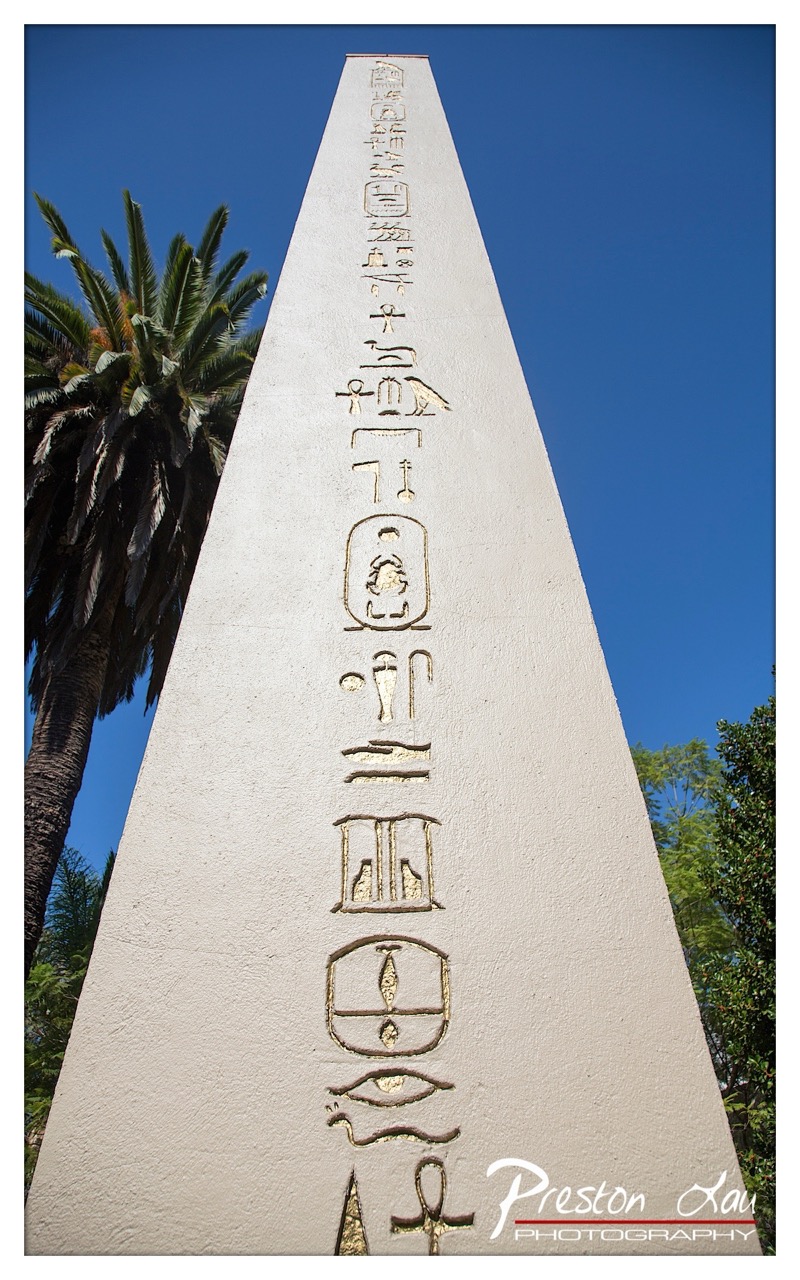

Sunny Obelisk Speaks in Gold
Rating: Subject 7/10
Ah, the classic "Look up at the big pointy thing!" shot. This photo captures a modern obelisk reaching for the heavens under a brilliant, cloudless blue sky. The subject, an obelisk adorned with striking gold hieroglyphs, gets a solid 7/10 – it's certainly eye-catching and full of intriguing details, even if it feels a bit out of place next to that very relaxed-looking palm tree. Everything is happening exactly as it should: the sun is shining, the sky is blue, and this faux-ancient monument is just standing there looking important. The mood is bright, clear, and evokes a sense of grand, slightly sunburnt history. You can almost hear the Indiana Jones soundtrack kicking in, albeit maybe a version played on a ukulele.
From a photographic standpoint, the low-angle composition is spot-on for conveying scale, though it does introduce a bit of perspective distortion, making our pointy friend lean just a touch like it's had one too many pyramid-inis. The harsh direct sunlight is a double-edged sword; it makes the gold hieroglyphs gleam dramatically, giving them a nice pop, but also creates some strong shadows and flattens the texture on the main obelisk surface. The colors are vibrant, almost aggressively so – that sky is *blue*, the gold is *gold*, and the green is, well, very green. It screams "sunny day!" The style is straightforward, perhaps leaning towards a travel snapshot with artistic aspirations. Pertinent objects include the star obelisk, its golden scribble language, a dramatically droopy palm on the left doing its best impression of an Egyptian fan, and some generic greenery on the right. Oh, and let's not forget the prominent watermark claiming photographic territory, which adds a touch of modern reality to the ancient facade.
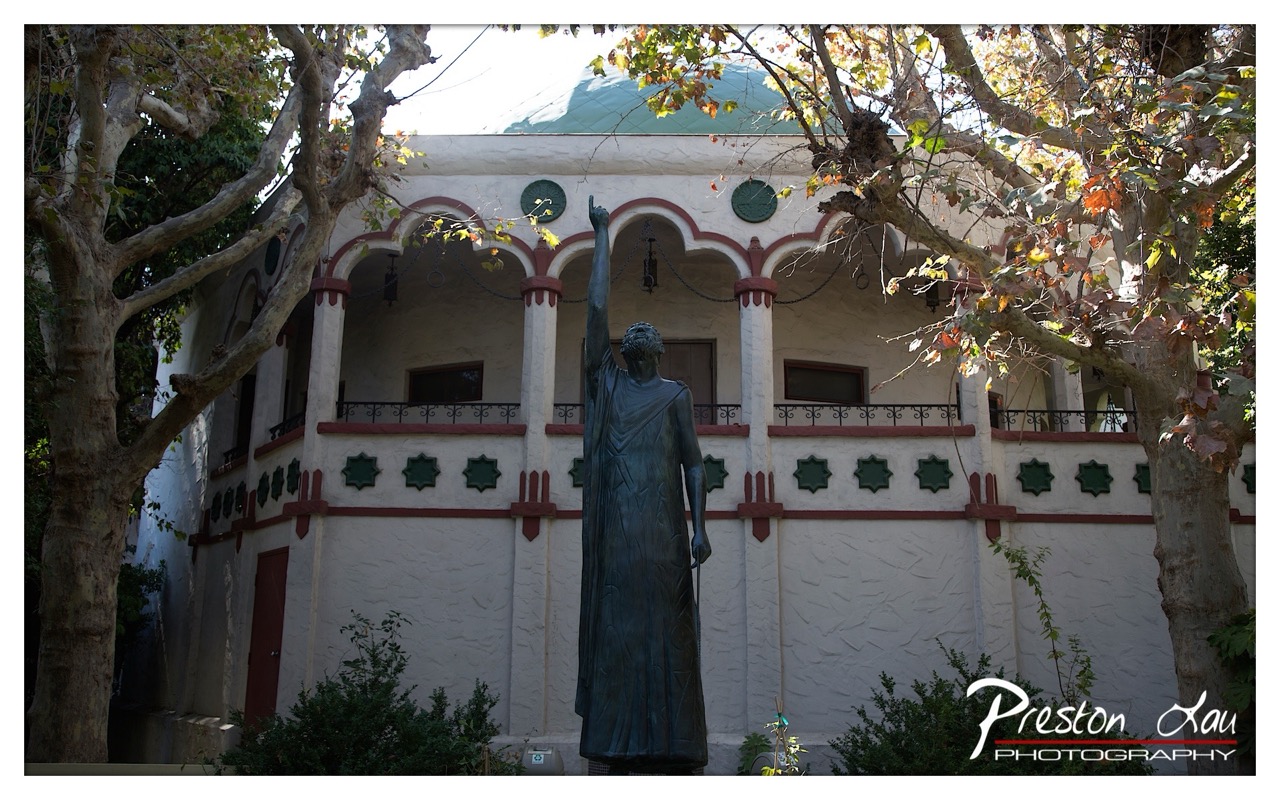

Title: The Pointing Prophet and the Peculiar Palace
Rating: 7/10
Behold, a scene where a solemn bronze figure stands before a building that looks like it escaped from a fantastical Moorish tale, dramatically pointing skyward as if asking the heavens, "Did I leave the oven on?" This noble subject, a statue with an undeniable sense of urgency in its raised arm, combined with the intriguing architecture behind it featuring ornate arches, slender pillars, a balcony railing that screams "period drama," and delightful star-shaped green tiles, certainly makes for a visually rich tableau. The building's stucco facade, textured like a well-used sponge, is topped by a distinctive green dome peaking over the arched portico. Framed by sprawling, gnarly trees that lend a touch of ancient gravitas (and conveniently obscure parts of the upper structure), this composition presents a unique blend of sculpture and architecture, earning the subject ensemble a solid 7 out of 10 for sheer intrigue.
From a photographic perspective, this shot captures a moment bathed in rather unforgiving, high-noon lighting, creating dramatic highlights and deep shadows that give the statue a sense of depth but make the building's facade a bit contrasty. The composition utilizes the trees as a natural frame, which is a classic move, but perhaps they're a tad too enthusiastic about their framing duties, blocking some of the building's upper charm. The color palette is a pleasing mix of earthy tones, the patina green of the statue and dome providing nice counterpoints to the beige and terracotta. One appreciates the effort to include the full statue and the central portion of the building, capturing the dialogue between the two main elements, even if the foreground shrubs seem to be staging a miniature rebellion. And let's not forget the prominent watermark in the corner, just in case you thought this epic pointed finger was your own discovery.
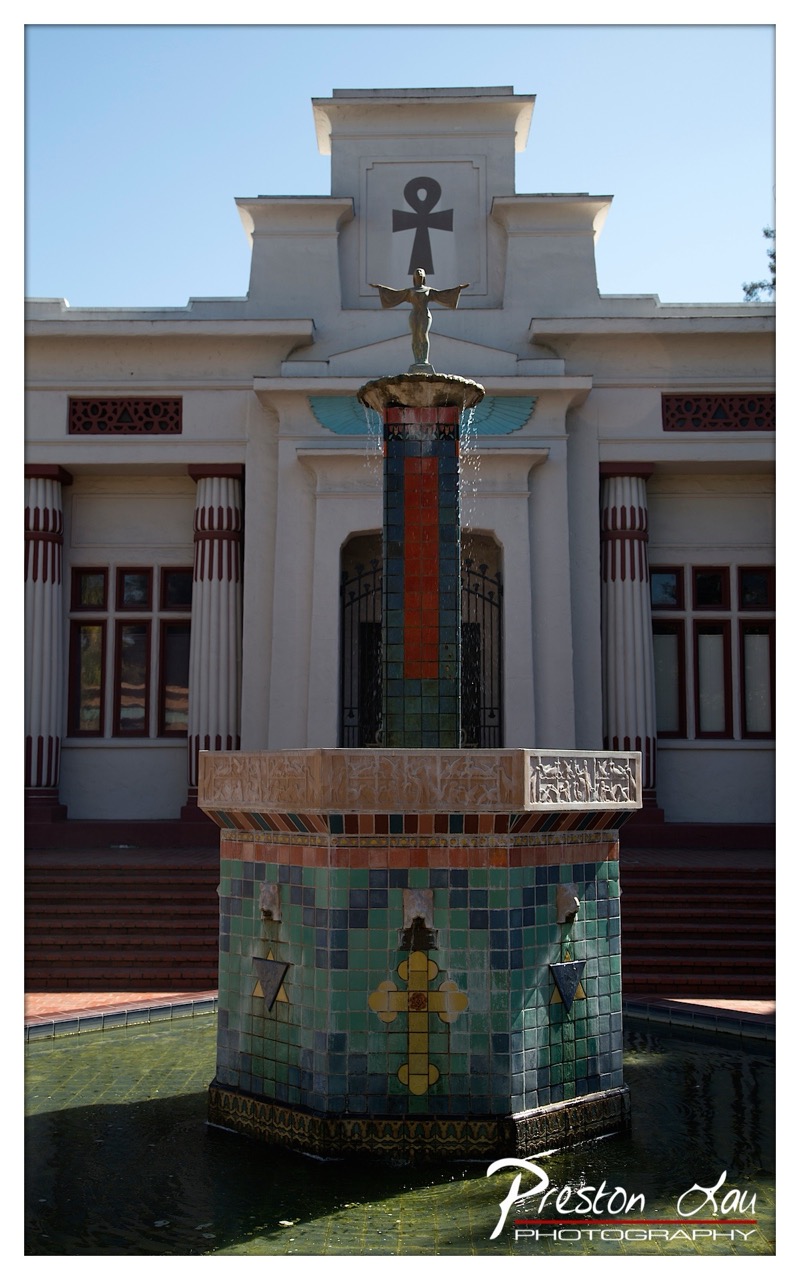

Ankh and Flow: Midday Drama
Subject Rating: 7/10
Behold, an Egyptian-inspired scene unfolding under a bright sky! The primary subject is a hexagonal fountain adorned with colorful teal, blue, and red tiles, featuring symbolic motifs like crosses and geometric patterns. Water cascades from a central column topped with a small, poised statue with outstretched arms, splashing into the pool below. Behind the fountain stands a building exhibiting clear Egyptian Revival architectural elements: towering columns with stylized capitals, recessed windows with reddish frames, decorative friezes, and a prominent Ankh symbol displayed above a smaller winged figure. The overall mood is one of historical grandeur mixed with a touch of quirky, possibly even kitschy, charm, all bathed in the relentless glow of midday sun.
From a photographer's perspective, this shot effectively captures the distinct subject matter, documenting the unique details of the fountain and building. The centered composition is straightforward and presents the subject clearly, though it leans towards safe rather than dynamic. However, the lighting tells a story of photographic struggles – the harsh midday sun creates intense contrast, plunging areas into deep, detail-crushing shadow while potentially blowing out brighter areas (though the exposure seems reasonably managed for such light). While the vibrant colors of the fountain tiles pop, the flat, direct light diminishes texture and form elsewhere. This serves as a classic example in a catalogue of how challenging midday sun can be; perhaps revisiting at golden hour or on an overcast day would yield a more nuanced and aesthetically pleasing result. The prominent watermark is, of course, a necessary evil for protection, but its size and placement are quite assertive.
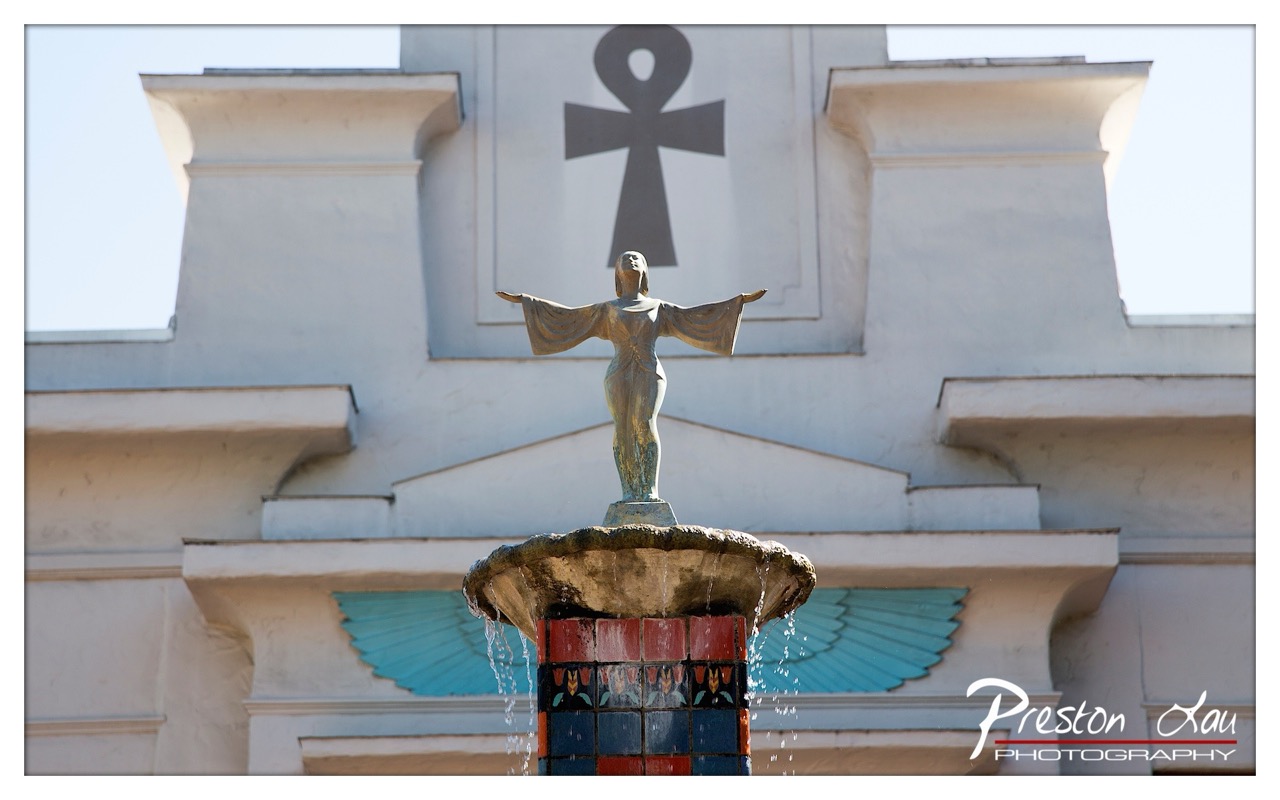

Title: Fountain of the Celestial Hug
Subject Rating: 8/10
In this intriguing shot, we see a stylized statue of a woman, arms outstretched as if embracing the sky or perhaps just airing out her dramatic sleeves, perched atop a rather funky little fountain. Water cascades down from the basin onto a cylindrical base adorned with colorful, patterned tiles and some cool blue winged details that seem to defy gravity (or perhaps represent some sort of avian-inspired architecture). Looming behind the fountain is a building with stark white walls and a prominent, dark grey ankh symbol centered above the statue, adding a touch of ancient Egyptian mysticism to the scene. The clear blue sky serves as a simple backdrop, letting the unusual elements of the fountain and building stand out. It's a peculiar tableau that feels like a quirky crossroads between classical sculpture, tiled fountains, and ancient symbolism, making for a memorable subject.
From a photographic standpoint, the composition centers the main subject effectively, placing the statue and fountain squarely in the frame. The photographer has used a relatively shallow depth of field, nicely isolating the fountain and statue from the background building, although the building elements are still recognizable. The lighting is bright and sunny, creating some contrast and highlights on the bronze statue and the water droplets. The colors are predominantly muted whites and greys from the building, providing a stark contrast to the more vibrant hues of the fountain tiles and the turquoise wings, which draws the eye downwards. The angle is slightly low, emphasizing the scale of the building behind the relatively small fountain and statue. While the bright light is good for exposure, a little more directional light might have added more dramatic shadows to the sculptural elements, but perhaps that would have detracted from the bright, almost whimsical feel. Overall, it's a well-executed shot that captures the unique character of this public art piece. And yes, that ankh is definitely judging my photography skills.
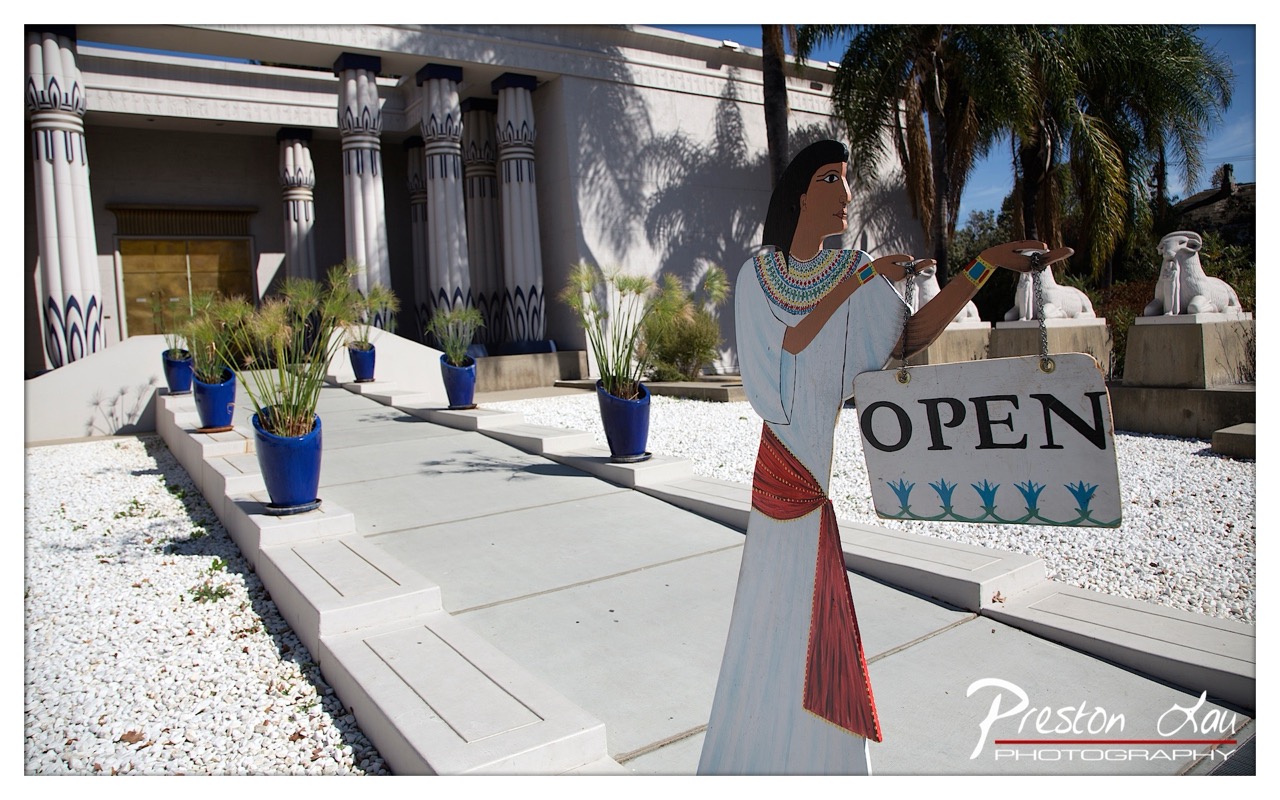

The Pharaoh's Greeter
Rating: 8/10
Welcome, mortal! This scene whisks us away to a sun-drenched, Egyptian-themed locale, where a life-sized, flat-packed figure of what appears to be a queen or noble stands proudly, beckoning visitors with an "OPEN" sign. The figure, adorned with a vibrant necklace and flowing white gown tied with a red sash, adds a pop of color and whimsy to the scene. Behind her lies a grand building fronted by towering columns painted with classic Egyptian motifs, suggesting a temple or perhaps a very dedicated themed attraction. The walkway leading up is flanked by manicured beds of bright white gravel, dotted with plants resembling papyrus in striking blue pots, creating a tidy, desert-like landscape. Two ram-headed sphinx statues sit regally in the background, guarding the entrance alongside tall palm trees casting long, dramatic shadows across the facade. The overall mood is one of quirky invitation, promising an encounter with something out of the ordinary.
From a photographic standpoint, the composition smartly places the cutout figure in the foreground as the primary subject, using the walkway and steps as leading lines guiding the eye towards the building behind. The bright midday sun provides excellent, clean lighting that highlights the architectural details and the vibrant colors of the figure, though it also creates some rather harsh shadows, especially those from the palm trees which add a touch of dynamic pattern to the otherwise flat building face. The contrast between the cool blues and whites of the architecture and pots, and the warmer tones of the figure and foliage, is visually appealing. The choice of white gravel creates a clean, bright base that mimics a desert floor effectively. It’s a fun, well-executed shot that captures the essence of this unique entrance, proving you don't need a real ancient civilization to make an impactful visual statement – sometimes, a smiling wooden cut-out and some dedicated landscaping will do the trick.
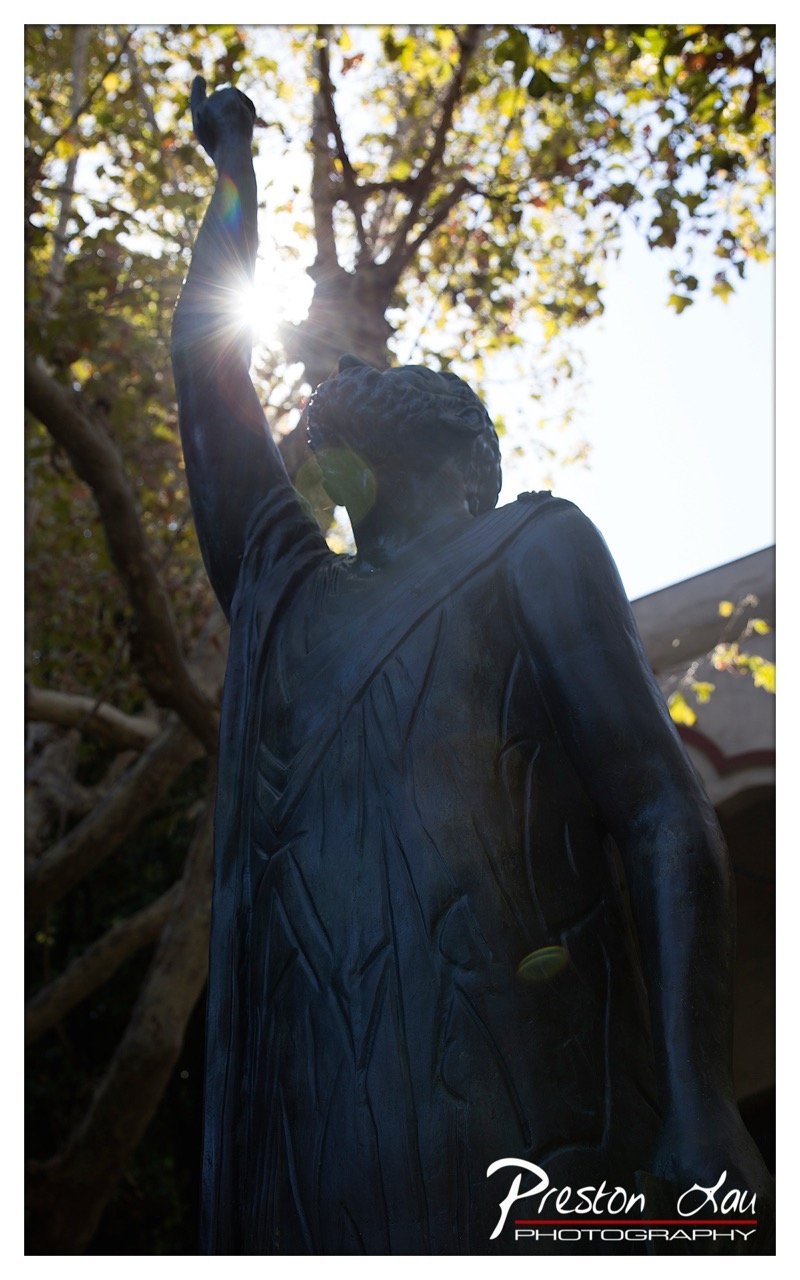

Reaching for the Light
Subject Rating: 7/10
Well, isn't this just a statue reaching for the sky like it's trying to catch a high-five from a celestial being? Or perhaps it's just been standing there for centuries and is *really* hoping someone will throw it a snack. Either way, this dark, robed figure is striking a dramatic pose, head tilted back, right arm extended straight upwards, pointing directly at the sun. What's happening is a classic interaction between sculpture and natural light, specifically the sun being perfectly positioned behind the figure's hand, creating an epic starburst effect and lens flare that dominates the upper left of the frame. The mood is definitely one of hope, aspiration, or maybe just profound longing, amplified by the powerful light source.
From a photography standpoint, this shot is all about embracing the drama of backlighting. The low angle makes the statue appear monumental, while the strong light source turns it into a striking silhouette, highlighting its form and the intricate folds of the robe without getting bogged down in surface detail. The composition uses the statue to frame the explosive light show in the sky, drawing your eye upwards along its arm. The out-of-focus background, consisting of leafy trees and a hint of a building, provides context without distracting from the main subject. The lens flare adds a touch of character, suggesting the intensity of the light source. It's a bold, high-contrast style that effectively captures a moment of interplay between static art and dynamic natural elements.
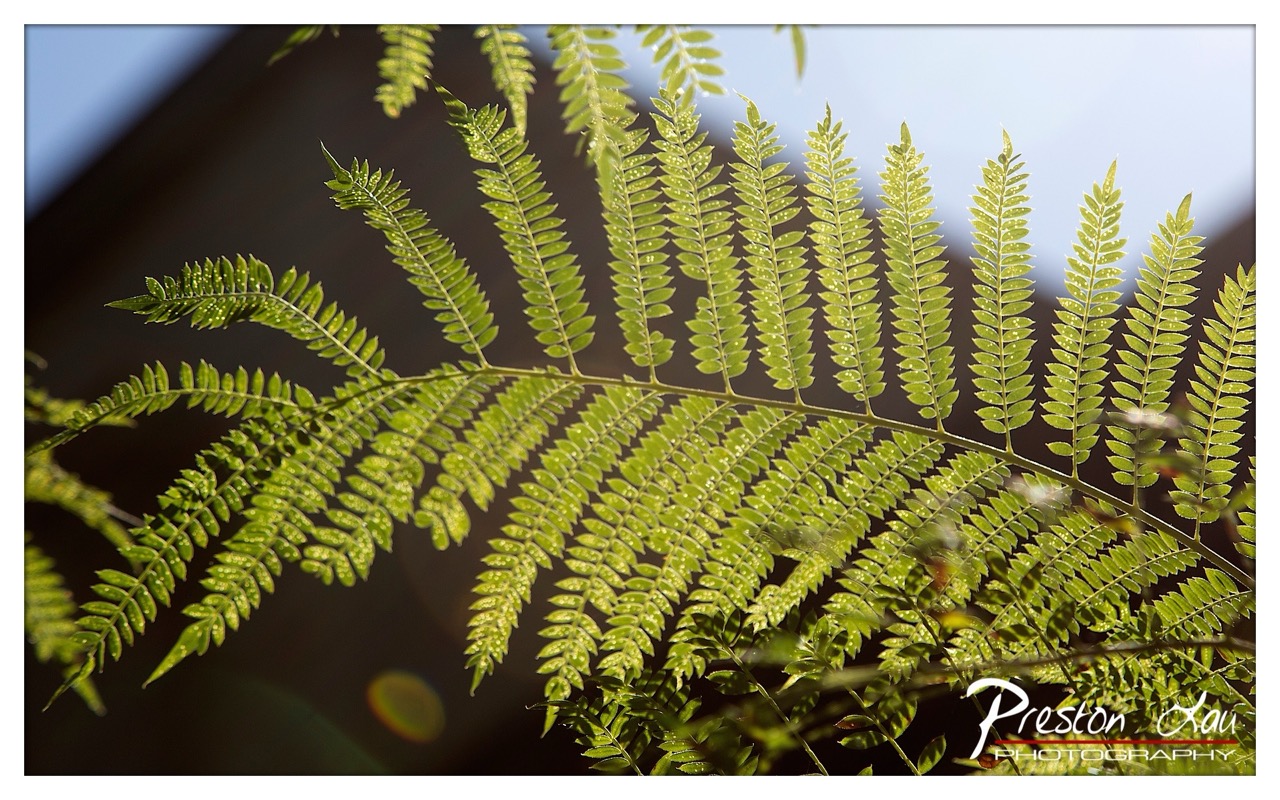

Fern-tastic Light Show
8/10
Ah, the humble fern. Often overlooked, but here it's getting its moment in the sun – literally! This shot gives a simple fern frond the superstar treatment, bathed in glorious backlight. What's happening is a botanical rave where sunlight hits the dance floor (the leaves), making them glow and sparkle with what looks like a thousand tiny diamonds or maybe just enthusiastic light reflections. The mood is serene and natural, but also vibrant and full of life, like finding a secret glowing oasis. The lush green of the leaves pops against the mysteriously dark, bokeh-rich background, which does a fantastic job of making the fern the undeniable main event.
From a photographer's eye, the composition uses the frond's elegant curve to sweep across the frame, adding dynamic movement and preventing the image from feeling static. The lighting is the real star here; that backlighting is chef's kiss, rendering the leaves almost translucent and turning dew drops (or maybe just shiny bits) into brilliant highlights. It's notoriously tricky to expose for such high contrast scenes, but the detail on the leaves seems well-maintained without completely blowing out the highlights. The color palette is simple but effective – vibrant green against deep shadow, with a hint of blue sky adding a touch of cool contrast up top. The style leans towards natural light close-up, capturing texture and form beautifully. Bonus points for the subtle lens flare in the bottom left, adding a little bit of that 'caught in the moment' magic, even if it was an accidental guest. Overall, a great example of how light can transform an ordinary subject into something quite extraordinary – proving even ferns can be divas when the lighting is right.